Lanzarote, the northernmost of the inhabited Canary Islands, has many truly magical places. In this guide, I’m showing you how to see the highlights of Lanzarote in only two days.
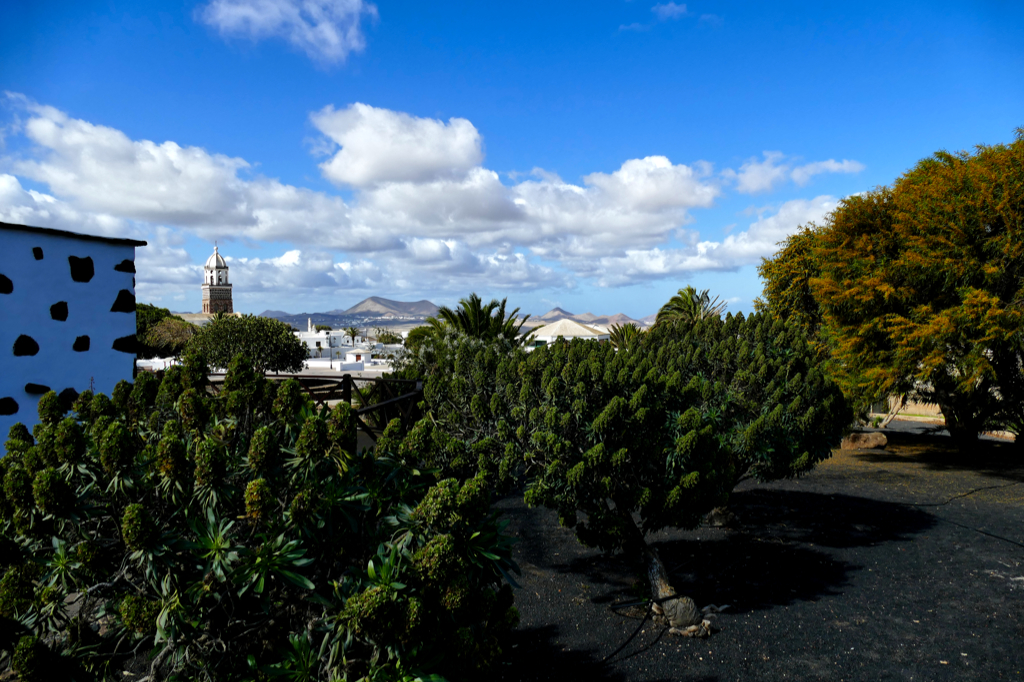
Born of Fire
Lanzarote is around 140 kilometers west of the coast of Morocco. And indeed, of all the isles, it has the least European feel to it.
Lanzarote is an island of volcanic origin. Black lava covers three-quarters of the island. 300 craters of approximately 100 volcanoes emitted masses that seemed to come straight out of hell.
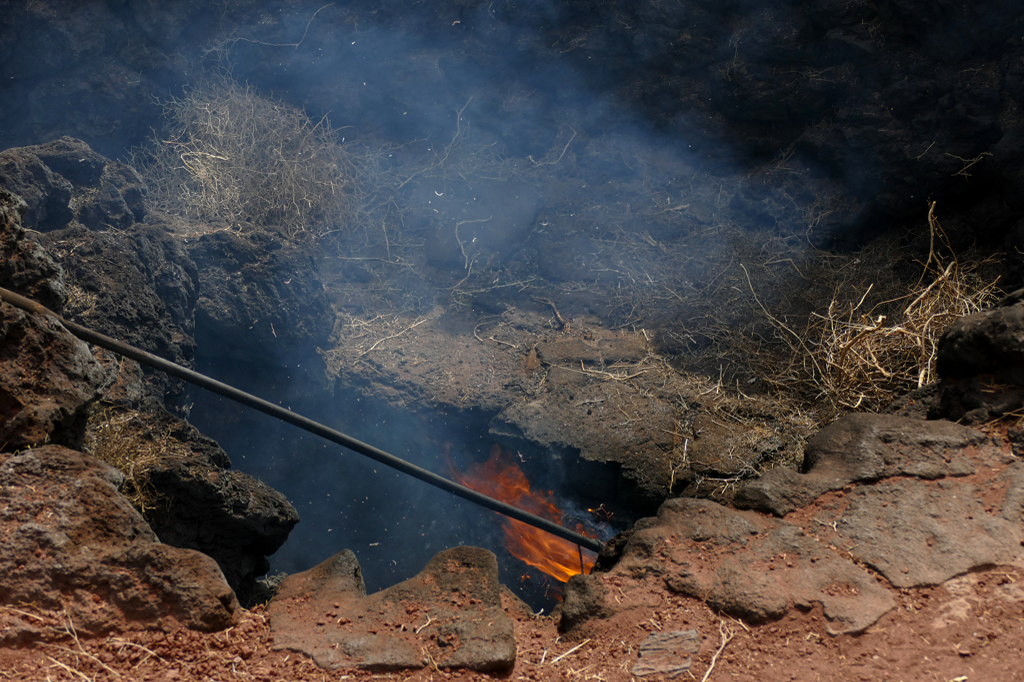
Lava from volcanic eruptions that lasted from 1730 to 1736 covered about a quarter of Lanzarote. Large parts of farmland and even entire villages were buried underneath. Apart from two eruptions in Iceland, this has been one of the largest magnitudes in the world. Nomen est omen – the area with the highest number of volcanoes was named Montañas del Fuego, hence, fire mountains.
Today, the Timanfaya National Park covers a large part of the affected area.
Don’t Leave Me This Way
Before the catastrophe hit the island in 1730, Lanzarote had produced wheat, barley, and other grains in abundance. The island was basically the archipelago’s granary. To keep enough workforce on the fields, the islanders were deprived of leaving Lanzarote. After the destructive volcanic eruptions, however, about half of the population migrated to one of the neighboring islands such as Gran Canaria, Fuerteventura, and Tenerife.
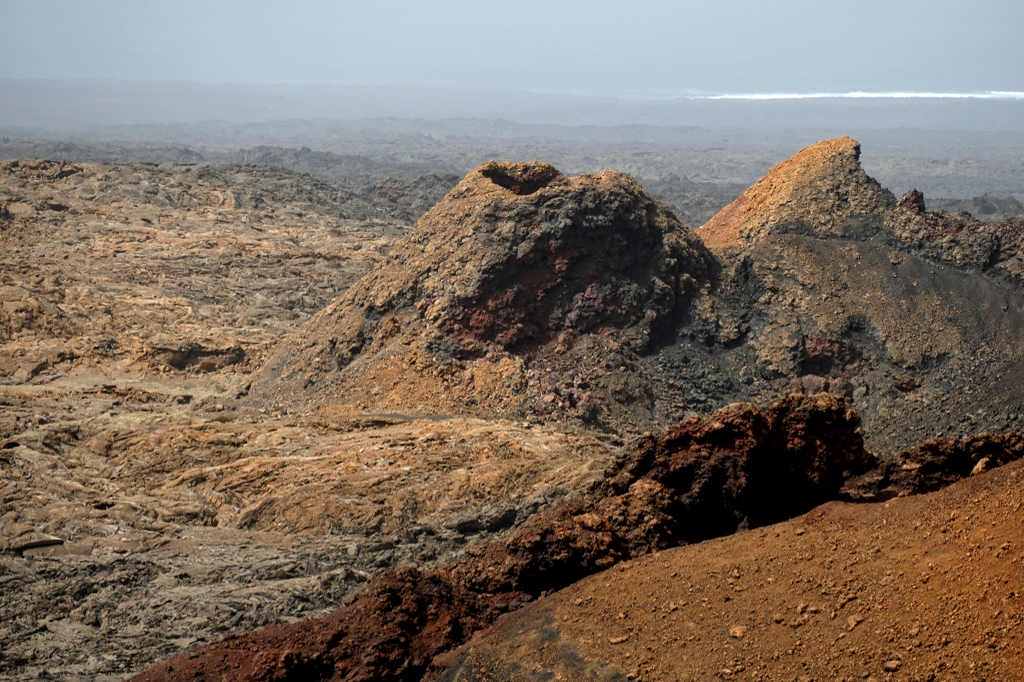
The infernal event was followed by a catastrophic drought in 1768. After the drought claimed countless lives, many residents emigrated either to the other islands or even all the way to Cuba and the Americas.
In 1824, there was another volcanic eruption in the Tiagua area. This, however, was by no means as consequential as the eruptions in the 18th century.
Human Threats
Homo homini lupus, in English, man is a wolf to man. Because as if the natural disasters weren’t tough enough to endure, Lanzarote’s inhabitants were also oppressed by their fellow human beings.
The original inhabitants of the Canary Island of Lanzarote were the Majos. Today, their culture is only known through archaeological finds and reports from seafarers from the 14th and 15th centuries. The Majos did not leave written documents. It is known that Catalans and Andalusians came from the mainland to capture natives that they eventually sold as slaves.
After subduing the inhabitants of Fuerteventura and El Hierro, Jean de Béthencourt left the Canaries in 1405. He commissioned his nephew Maciot de Béthencourt to rule over the islands.
From 1452, Inés Peraza de las Casas and her husband Diego García de Herrera y Ayala ruled the island. Their rights to power were confirmed by the Catholic Kings in 1477. Eventually, Inés’ son Sancho de Herrera inherited control over the island. His descendants remained the leaders of Lanzarote until the abolition of feudalism in the 19th century.
A Two-Day Trip From Fuerteventura
It’s early morning. I’m standing on the pier of Corralejo, the northern port of Fuerteventura. The morning air is cool from the night. I zip up my windbreaker and put on the hood.
At this hour only Canarians are at the jetty, many of them in cars. Tourists arrive later to take the ferry to Lanzarote for a day trip. I have a strict schedule and little time. Therefore, I booked the ferry at 7 o’clock although a later one would have been much cheaper.
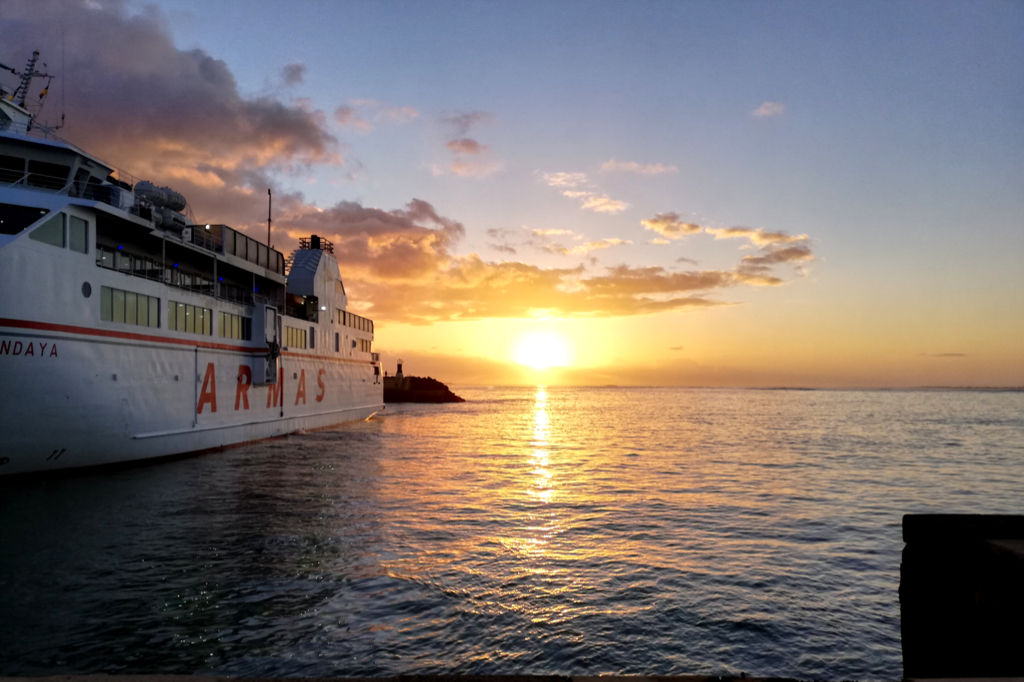
7 o’clock is brutal, but I’m rewarded with the magic and the balmy air of the early morning. The sky above the waves of the sea clears up in shades of delicate pink and orange. You can hear the hooting of the ship’s sirens, the screeching of the gulls, and the clanking of heavy chains as the ferry docks. Above all, there is a slight melancholy, wanderlust, and anticipation of a wonderful day.
Crossing to the Other Shore
The crossing to Lanzarote takes less than half an hour. The islands are only seven nautical miles apart. Finally, the La Bocaina Strait can even be crossed by swimming. Every year crazy sporty people swim from Playa Blanca in Lanzarote to Corralejo in Fuerteventura. Depending on their physical condition, they need between five and eight hours for the 15-kilometer route.
Since I don’t swim myself but let the ferry do all the work, I’m in the port of Playa Blanca after just under 30 minutes and hurry to the bus stop, where the excursion bus for my first tour on Lanzarote is supposed to pick me up.
I’ve hardly found the bus stop when the bus turns the corner, the guide calls my name, I hop on, and off we go.
And you, what are you waiting for? Come on, let’s explore all the island’s highlights. After all, we have just two days.
All the Island’s Highlights in Just Two Days
Salinas de Janubio
Leaving Playa Blanca to the northwest, our first stop was at the Salinas de Janubio, a huge salt plant.
The area of today’s salt pans is where all kinds of grain grew before the volcanic eruption in the 18th century. The volcanic activity created a lagoon of a depth of three meters. Operation of this plant began as a family business in 1895. As a matter of fact, there had already been natural salt deposits in the area.
Until the 1970s, over a hundred workers extracted up to 10,000 tons of salt in this area. It was mainly used by fishermen to preserve their catch. Then, the catch quotas dropped and modern cooling systems were installed. This reduced salt production drastically. Nevertheless, to this date, the salt pans cover an area of around 45 hectares.
Sea salt, especially the precious flor de sal, and related products like for instance cosmetics are very popular souvenirs.
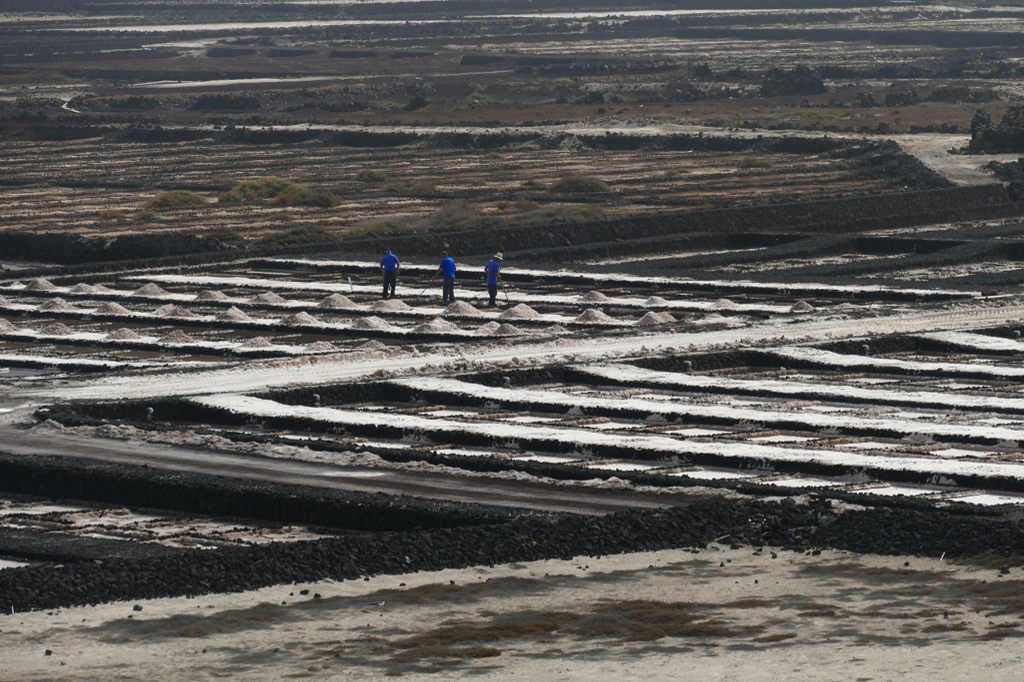
This was actually not my first trip to a salt mine. Some time ago, I visited a similar site on Sal, one of the islands of Cape Verde. There, we were even allowed to float on the salt pools. I only hope they didn’t add that very salt to their soup in the evening.
Timanfaya
Next, we went from the white fields of sea salt to the black fields of lava. Finally, we were heading to the Timanfaya National Park. As a matter of fact, this part of the tour was why I had squeezed in a trip to Lanzarote at all. On my first trip to Fuerteventura a couple of years ago, we visited Lanzarote on a day trip and I was totally blown away by the shenanigans of the earth. To me, it was like a visit to a believe-it-or-not show. Hence, I wanted to witness all these natural wonders again.
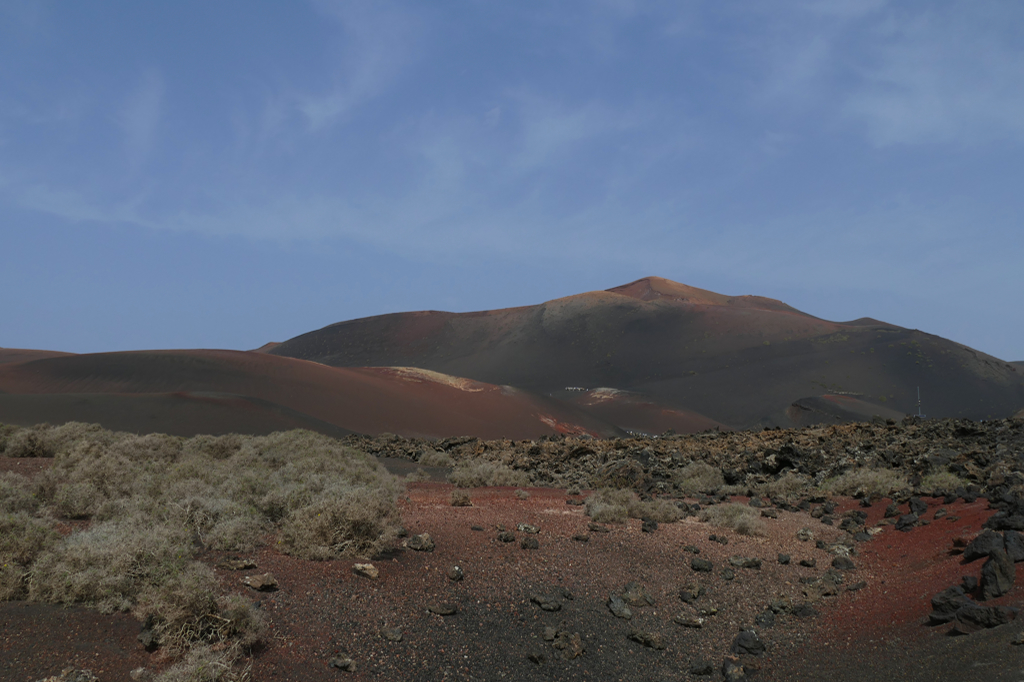
The route of the volcanoes within Timanfaya National Park is one of the most memorable places to visit in all of the Canary Islands. The volcanoes in this protected area are part of what is known as the Hawaiian Group.
The flow of lava in 1736 stopped at the Montaña de Guiguan and thus spared the surrounding villages. For whatever reason, the villagers were convinced that the Virgen de Los Volcanes had done her magic, so they promised to build her a chapel in return. The Ermita de Los Dolores was constructed in Mancha Blanca. During the eruption of 1824, the distressed villagers of Mancha Blanca marched in a procession toward the boiling lava, carrying the Virgen de Los Dolores. And indeed, the lava came to a standstill shortly before the village’s first house in the village. The Virgen had struck again.
Today, an information and visitor center stands at Mancha Blanca where you can learn a lot about all the hot stuff around.
The Heat Is On
A more centric point is the Taro de Entrada from where you also access the Montañas del Fuego, the fire mountains.
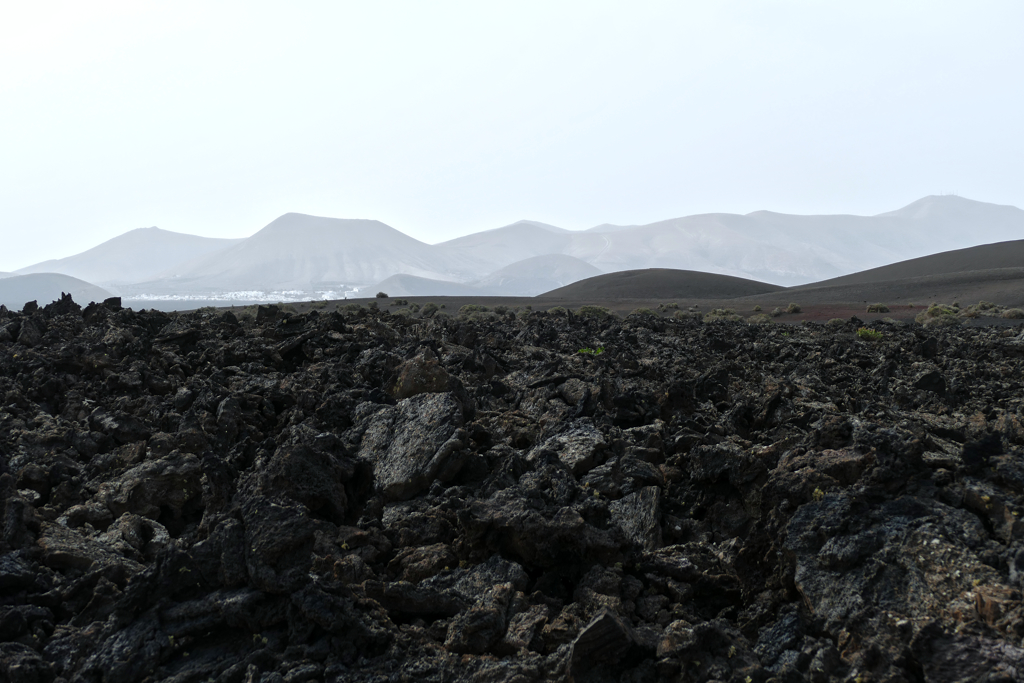
The national park spreads over more than 51 square kilometers. It starts at the outskirts of the village of Yaiza and goes all the way to the Montaña Timanfaya. You can only visit it by bus on a 14 kilometers long tour, not by private vehicle.
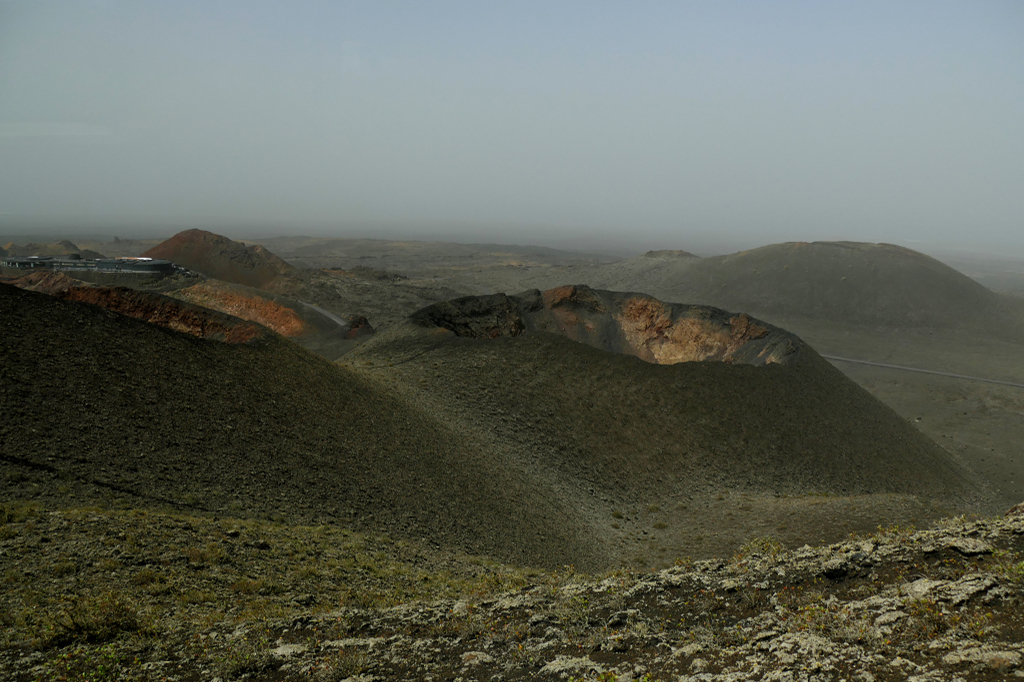
Since the disaster, eight million cubic meters of lava lay where there once were towns and farmsteads. This area is ghoulishly called Valle de la Tranquilidad which translates to valley of tranquility, obviously.
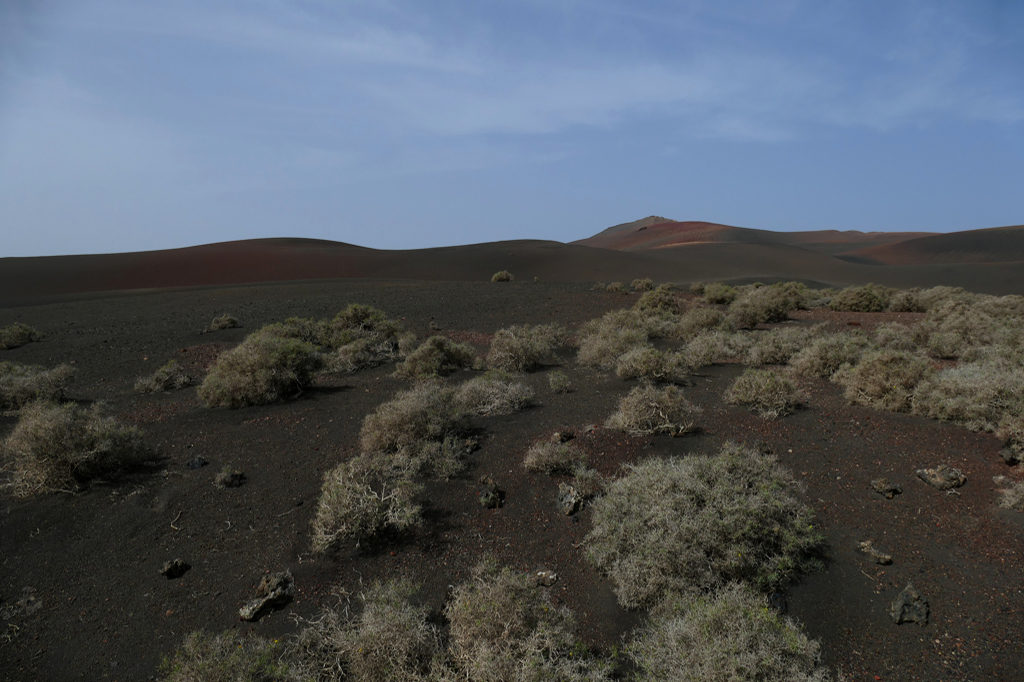
Only very slowly has some vegetation formed again on the so-called Malpaís, in English bad land. Prickly shrubs, succulents, as well as lichens, symbiotic organisms of fungus and alga, are growing between respectively on the rocks.
Those shrubs are used by the park rangers to illustrate the high temperature of the ground in the Islote de Hilario area. Stuffed into a hole in the ground, the dry branches immediately burst into flames. In another demonstration, the rangers are pouring water into a pipe embedded vertically in the ground. Since the temperature a few meters below the earth’s surface is higher than 400 °C, a steam fountain rockets into the air.
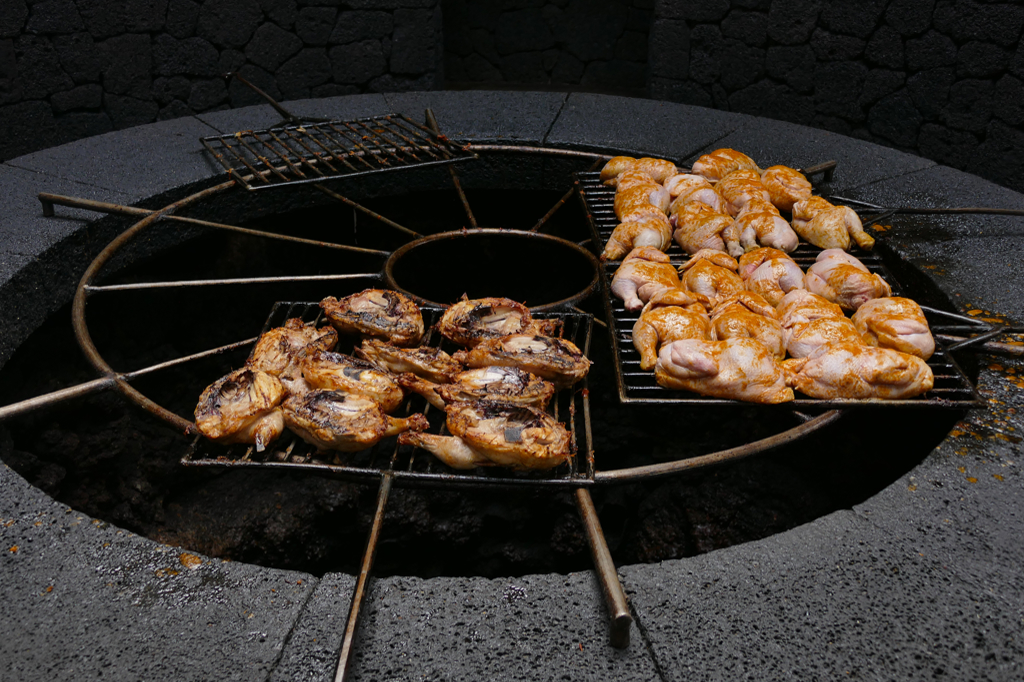
Another fun demonstration of the incredible heat is the cooking area over a hot hole. This truly unique grill stands at the restaurant El Diablo. It was built by – I’m sure you already guessed so – César Manrique.
Casa Museo del Campesino and Monumento a la Fecundidad
Okay, so there are all the craters, there is the lava, the earth is spitting, in short: There’s a lot going on in Lanzarote. Yet, there is another force in Lanzarote that goes by the name of César Manrique. No matter where you go, you’ll run into one of his ingenious creations.
The artist César Manrique contributed significantly to the appearance of the island. Not only did he create sculptures and even buildings and unusual resorts. In 1968, Manrique convinced Lanzarote’s government that no building on the island should be higher than three storeys. That’s generally the height of a full-grown palm tree. And indeed, for a long time, there was only one high-rise building in the island’s capital Arrecife.
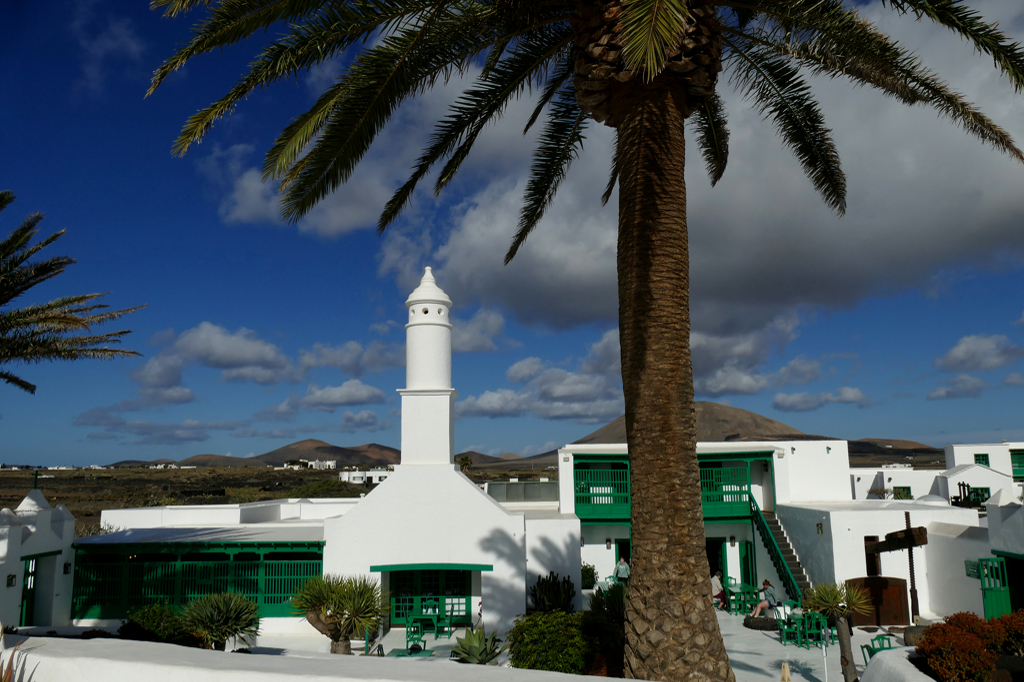
In the center of Lanzarote, at a crossroads in San Bartolomé, is the farmer’s museum Casa Museo del Campesino. César Manrique created this exquisite example of the island’s traditional architecture.
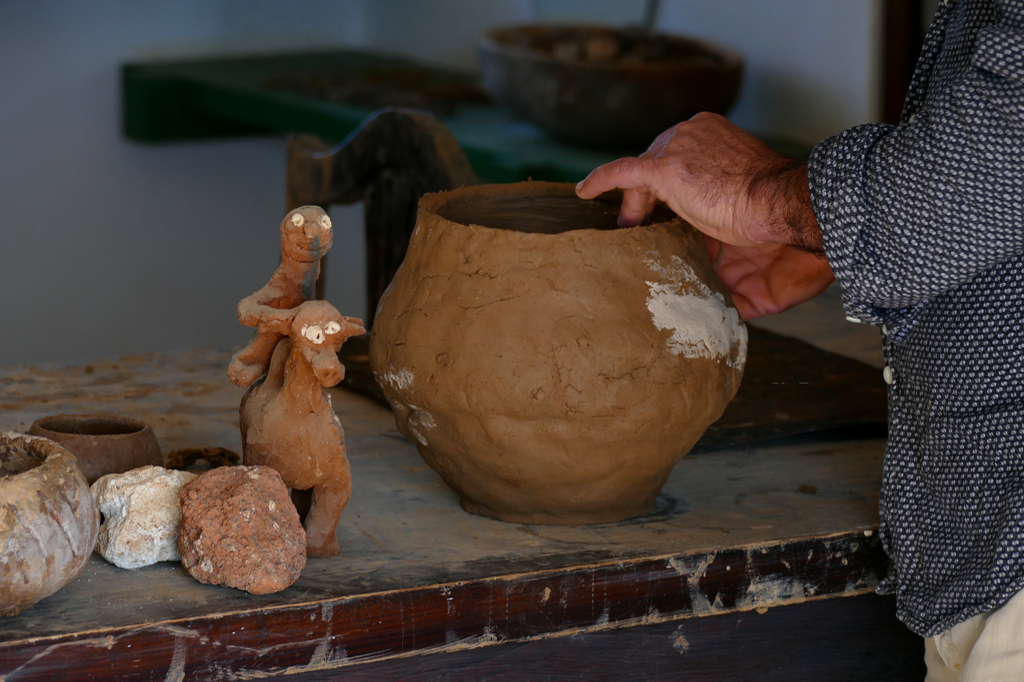
From the center of the patio, you access a grotto that was once a quarry. Today, however, the grotto houses a gourmet restaurant serving local food. Inside the museum, you learn about the traditional rural life in Lanzarote. Also, you get to watch artisans creating local handicrafts. Obviously, their products also make wonderful souvenirs.
Street Art
In front of the museum’s entrance is a 15-meter-high sculpture honoring the island’s peasants. Manrique built this so-called monument of fertility from disused water tanks in 1968. Just use your imagination to spot a donkey, a camel, and a farmer wearing a sunhat in those geometric shapes.
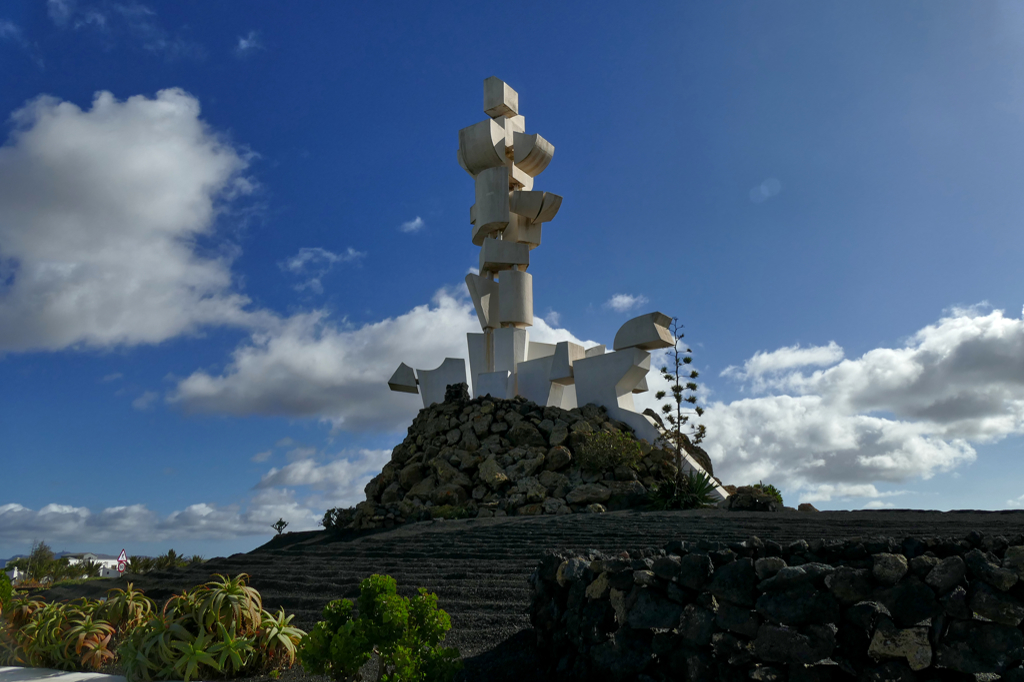
The Monumento al Campesino complex is open every day from 10 a.m. to 5.45 p. m. and the entrance is free of charge. The restaurant is only open for lunch from noon until 4.30 p.m. – which gives you an idea of how late Spanish meal times are.
LagOmar
And off we went to another innovative building created by grandmaster Manrique, however, in cooperation with Jesús Soto.
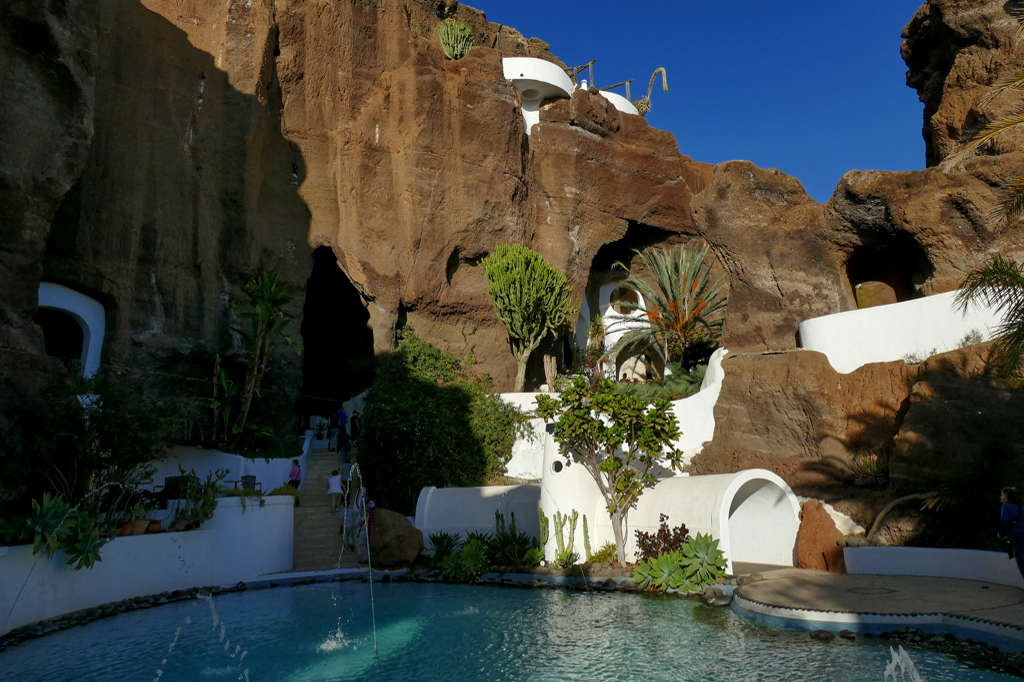
It was during the crazy 1970s that British property developer Sam Benady commissioned Manrique and Soto to create a home within a volcanic quarry. They then constructed it around the same rock the building material came from, adapting it to the molten lava on the slopes of an ancient volcano, showing raw stone walls and white-washed concrete.
Rumor Has It
Benady’s initial intention was to show it off to people interested in purchasing properties in this area. However, legend has it that Hollywood film star Omar Sharif came to Lanzarote to shoot the movie The Mysterious Island after the classic novel by Jules Verne. What you see is what you get – Sharif saw the building, fell in love with it, and bought it.
Sam Benady knew about the actor’s passion for gambling. Hence, he challenged him to a game of bridge whereupon Sharif lost the property. Obviously, he wasn’t aware that his opponent was the European Bridge champion.
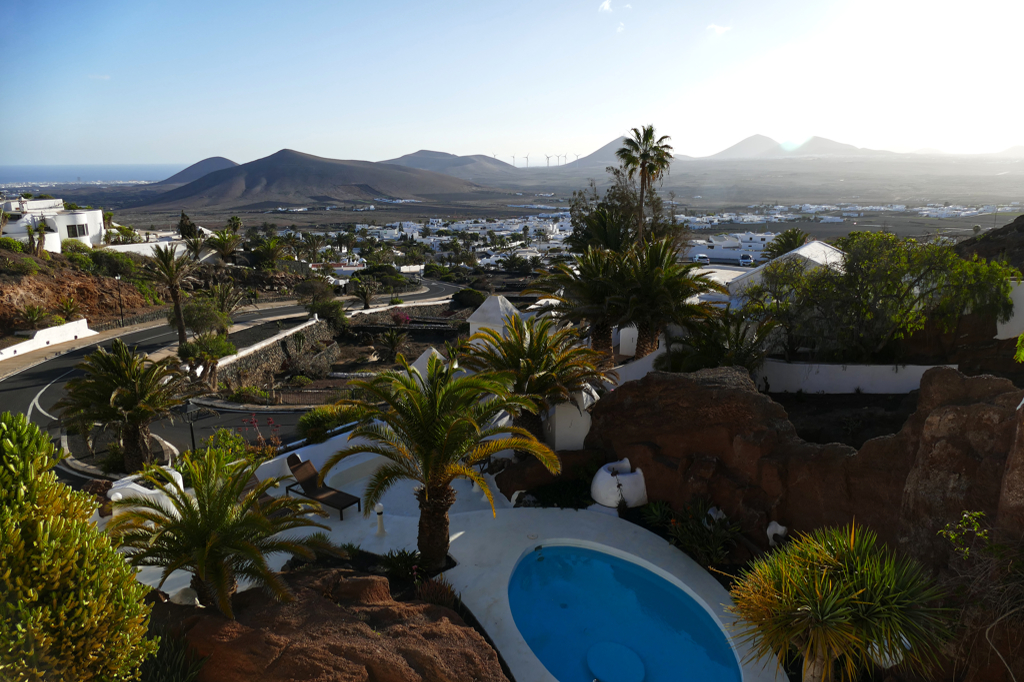
To this date, the house is known by the name Casa Omar Sharif notwithstanding the fact that its short-time owner never returned to Lanzarote again.
Since 1997, LagOmar has been a museum, art gallery, bar, and restaurant. It is open to the public every day from 10 a.m. to 6 p.m. for a general entrance fee of 6 €uros.
Teguise Village
From LagOmar, we headed to the centrally located townlet Teguise. As I pointed out above, I had come to Lanzarote mainly for the Timanfaya reserve and had never heard of this gem before. Just like for instance Fornalutx on the island of Mallorca and Tejeda on Gran Canaria, Teguise was declared one of the most beautiful villages in all of Spain in 2019.
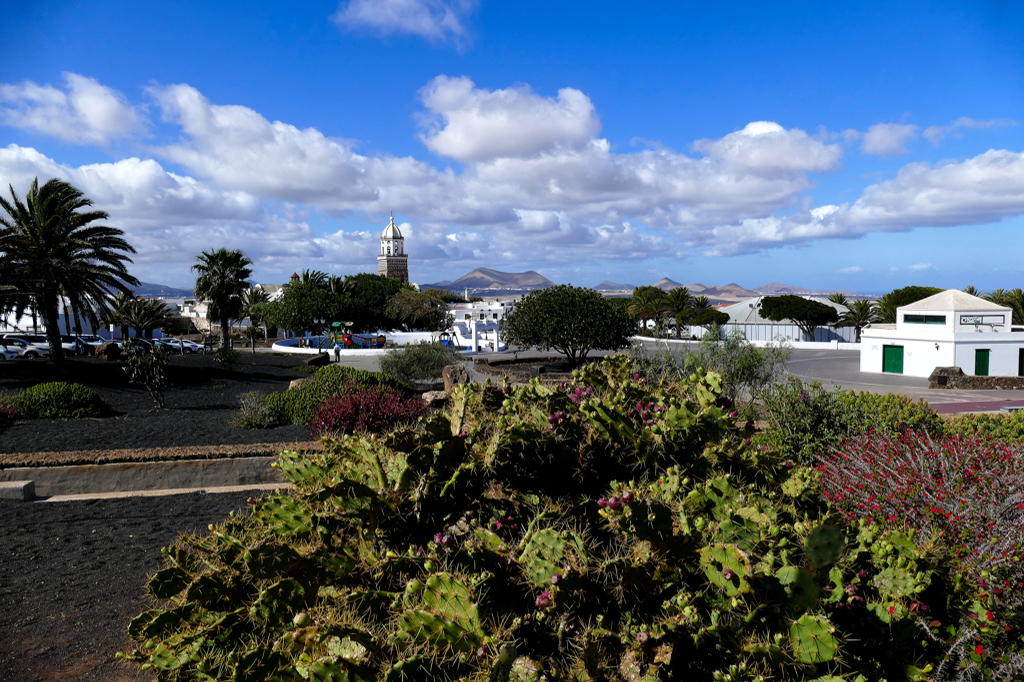
Teguise was founded around 1406 by Maciot de Béthencourt as a colonial city under the name of Gran Aldea de Acatife. It was later renamed Teguise. Teguise was Maciot’s mistress, a daughter of the island’s last indigenous ruler.
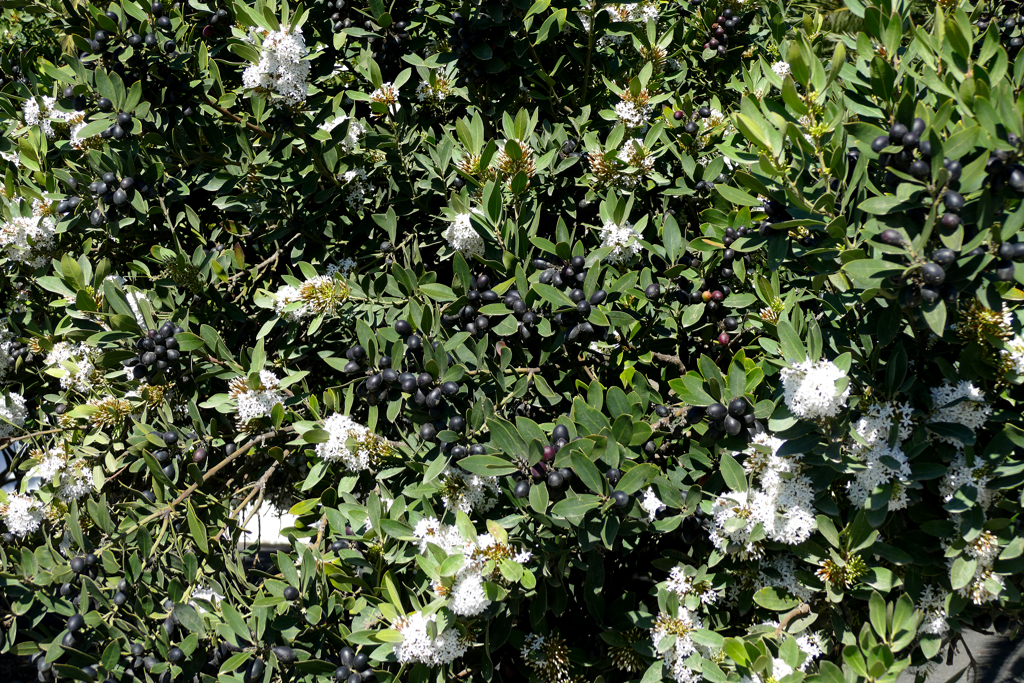
In 1586, the North African pirate Morato Arraez sacked the city, murdering and enslaving the residents. A plaque in Callejon de Sangre, Blood Alley in English, commemorates this catastrophe. Sadly, this kind of raid continued up to the 18th century.
In 1852, Teguise was replaced as the island’s capital by the thriving coastal town of Arrecife.
On the Town
The bus parked on the outskirts of Teguise and we strolled towards the central square Plaza de la Constitución.
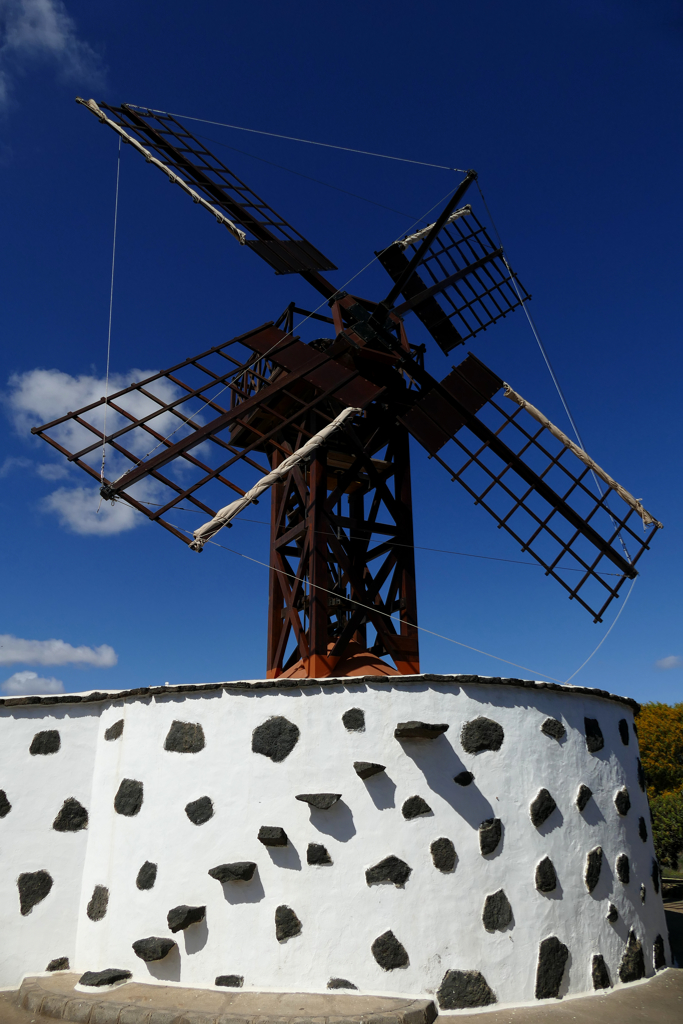
It’s surrounded by palm trees, Indian laurel trees, and Araucaria and you find some of the most important historic buildings here whereby the church of Nuestra Señora de Guadalupe is the most significant one.
Nuestra Señora de Guadalupe was originally built in 1428. Its most prominent feature is the bell tower made of red volcanic rock. After having been destroyed during pirate raids several times, in 1909 a fire caused great damage.
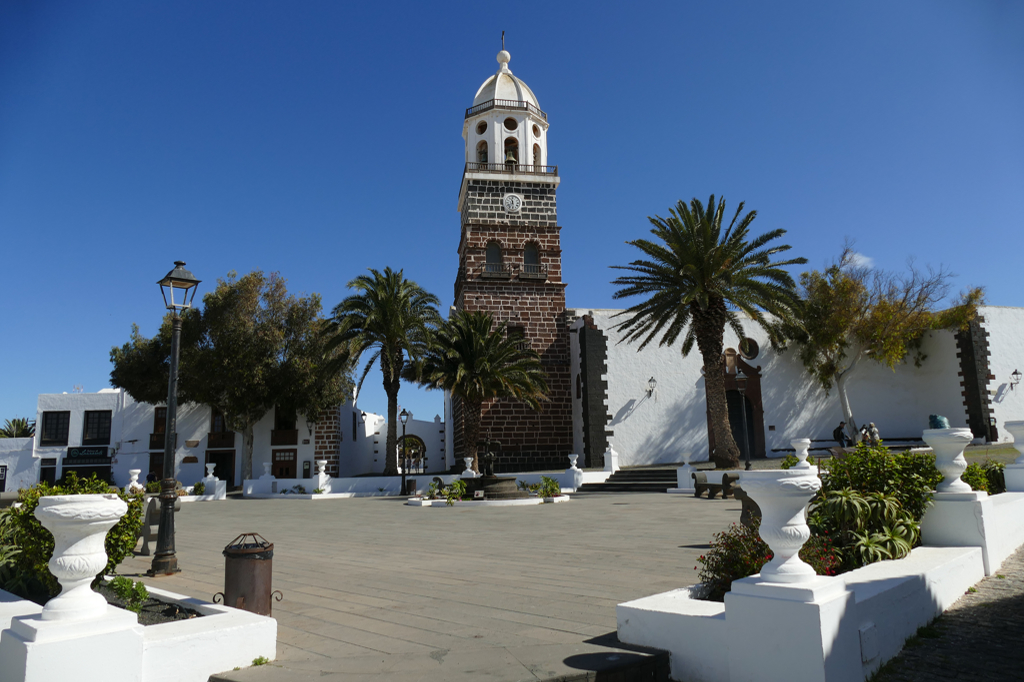
Behind the church is the Mareta cistern. With a diameter of 40 meters and a depth of nine meters, it is the largest cistern in Lanzarote. The rainwater streaming down the Guanapay volcano is collected in the corridors under the square. Unfortunately, the widespread canal system of the lava rock catacombs is not open to touristy visits.
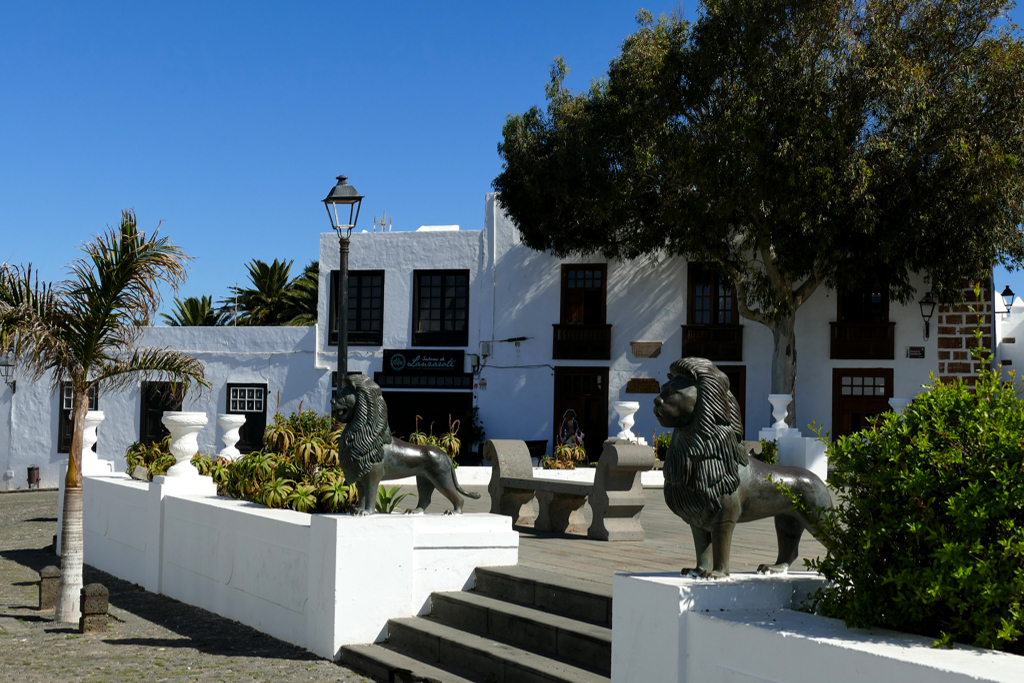
Opposite the parish church of Nuestra Señora de Guadalupe is the Palacio Spinola. José Feo Peraza commissioned this town palace in 1730. Until 1974, it was home to various noble families. The façade and the porch along with the grand foyers, a chapel, courtyards, and cisterns prove the family’s political and military power. Guess who remodeled it eventually? Correct, César Manrique. Today, it houses the so-called Casa del Timple, a museum dedicated to a small traditional guitar-like instrument.
So Much Beauty, So Little Time
I have nothing against organized tours, obviously. I had come to Lanzarote to go on two pre-customized day tours, after all. One of the downsides, however, is that people like different things. And while others might have liked to spend half of the trip at the winery that I’ll get to below, I could have spent much more time exploring beautiful Teguise. Come to think of it, I can absolutely see making myself at home for a week or two and exploring the island from there.
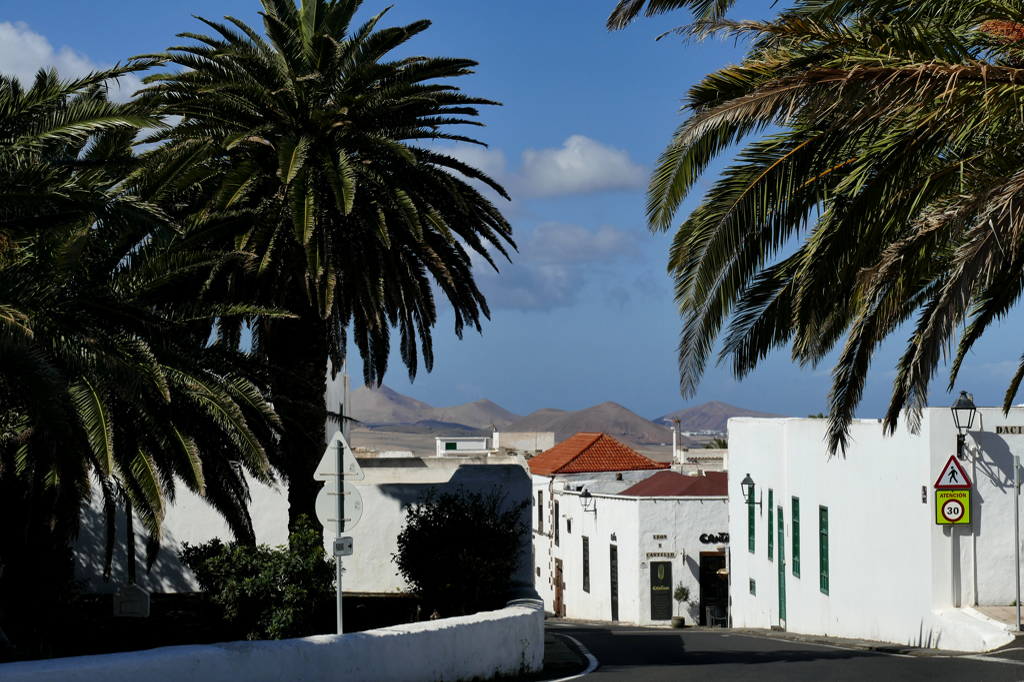
But we had about an hour which was next to nothing, so come on, let’s pace so I can show you at least the most meaningful’n’majestic of Teguise’s historic structures.
Let’s Go to San Francisco
Apart from the main square, the Plaza San Francisco ought to be one of the spots not to miss. Obviously, it was named after the two-nave church of San Francisco which was consecrated in 1590. In 1618, the former Franciscan monastery fell victim to one of the main pirate attacks. With the help of generous donations, the two-nave church was rebuilt and a beautiful portal and wooden ceilings were added. Today, it is a cultural center for concerts and exhibitions at the adjacent Museo de Arte Sacro.
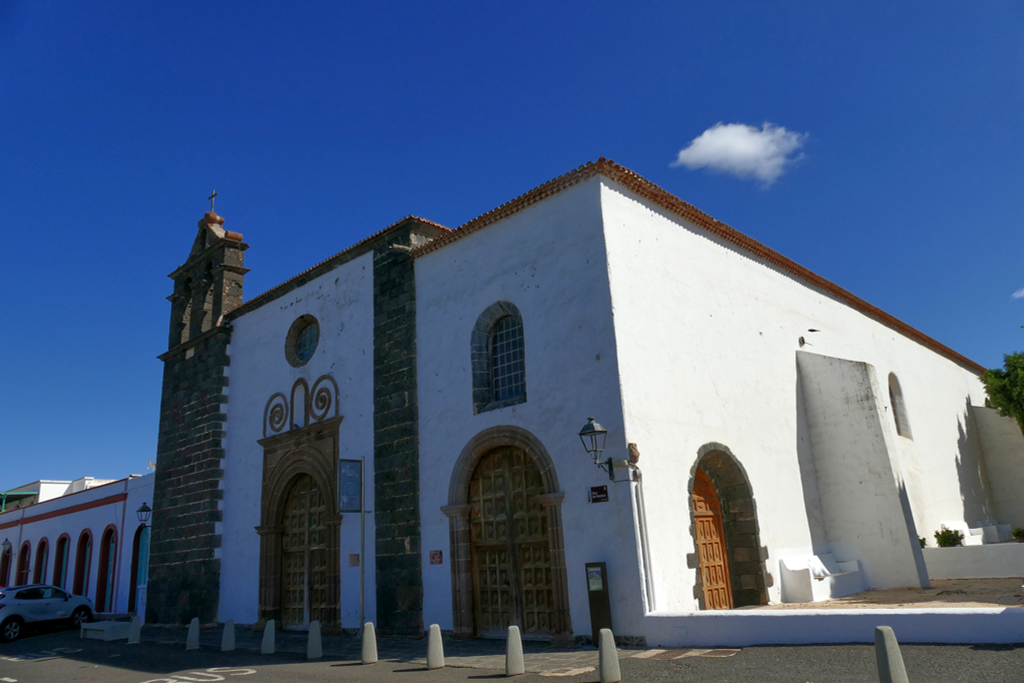
Normally, the museum is open from Tuesday to Saturday between 9 a.m. and 4 p.m. and Sundays from 10 a.m. to 2 p.m. The general entrance fee is 2 €uros. However, don’t be too disappointed if it’s not open, you know how these things are.
Another former house of worship that was remodeled into a cultural venue is the Convento de Santo Domingo. You’ll find it south of the town center.
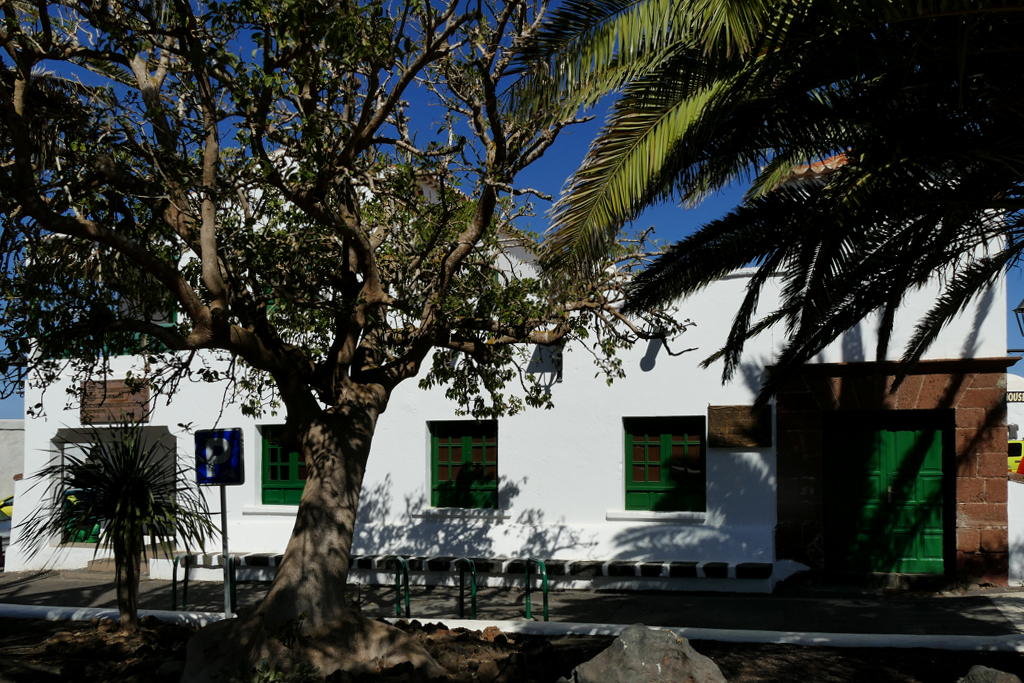
Also at the Plaza de San Francisco is the former Casa Rural del Médico. The doctor’s house was officially named Casa doctor Spinala as a tribute to Alfonso Spinola Vega. He was a devoted physician, professor, and philanthropist. Among other things, he founded South America’s first anti-rabies microbiology laboratory in Uruguay. Today, the building houses municipal offices.
Walking Through History
As I said, sadly, I didn’t have enough time to explore all Teguise has to offer. That’s especially annoying since the Teguisiens in charge seem to cherish their rich heritage. For example, they put explanatory plaques in Spanish and English next to historically significant places.
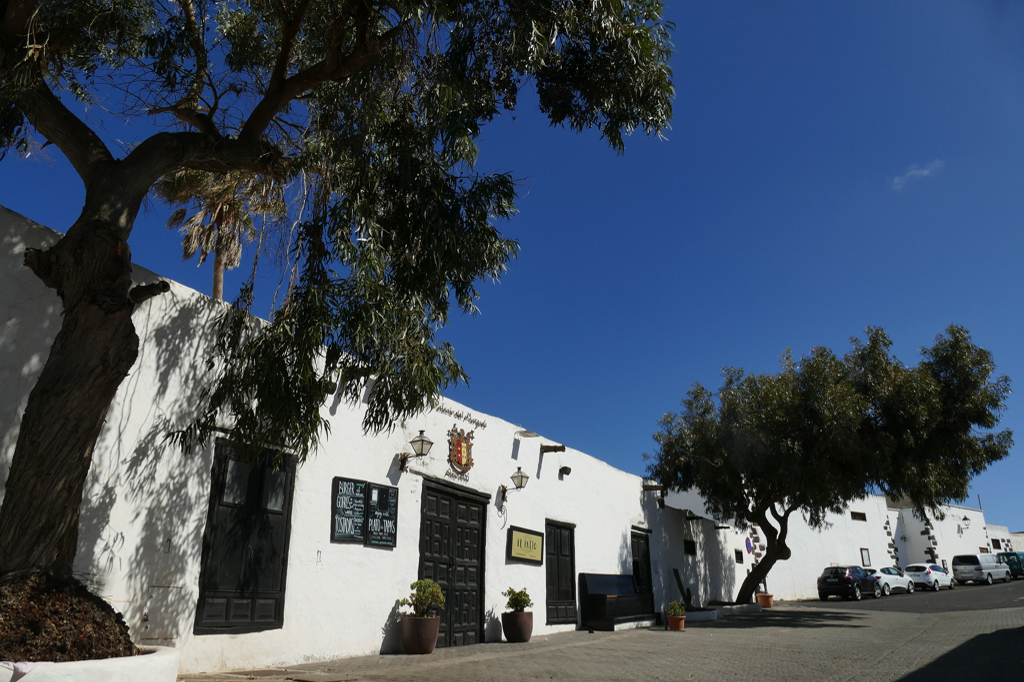
For instance the Casa Palacio de Los Marqueses de Lanzarote. This palace housed the island’s government. It had to endure several raids by Berber pirates. In 1618, it was besieged and burned to the ground during the invasion of the Ottoman corsair Murat Reis the Elder. All the stops were pulled out to rebuild it and resume governmental activities. One of the Palacio’s most interesting features is an aboriginal footprint on its walls.
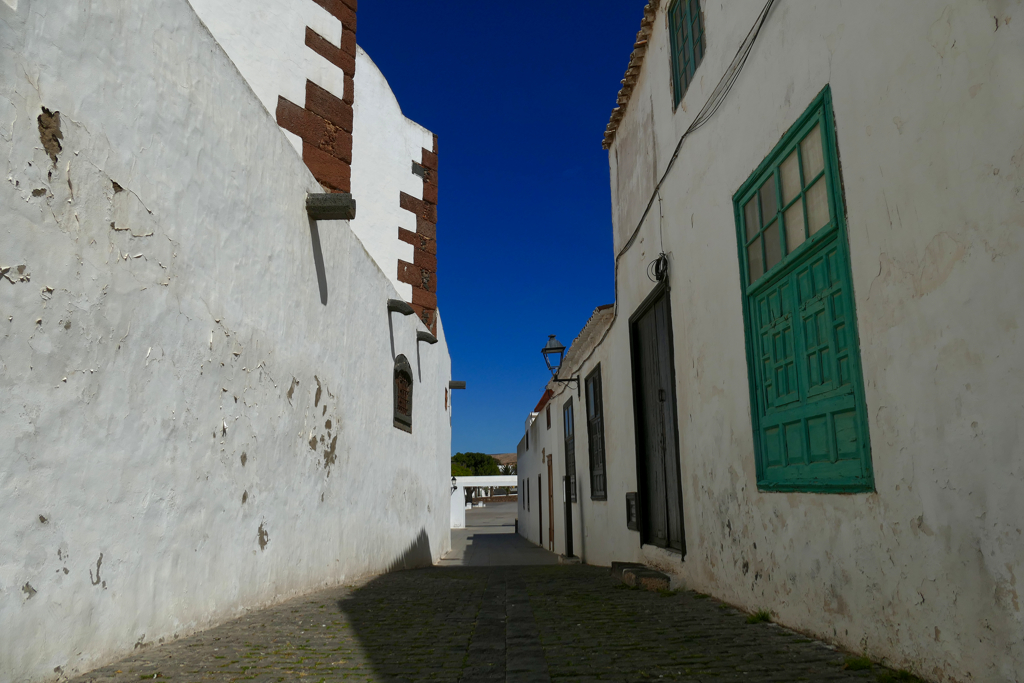
As you turn right at the next corner, you’ll access a true-to-life tunnel of horror. The street behind the church Nuestra Señora de Guadalupe is named Calle la Sangre, hence, Blood Street, for a reason. Initially, water used to flow from Valle de Miraflores to Gran Marata down the old ravine.
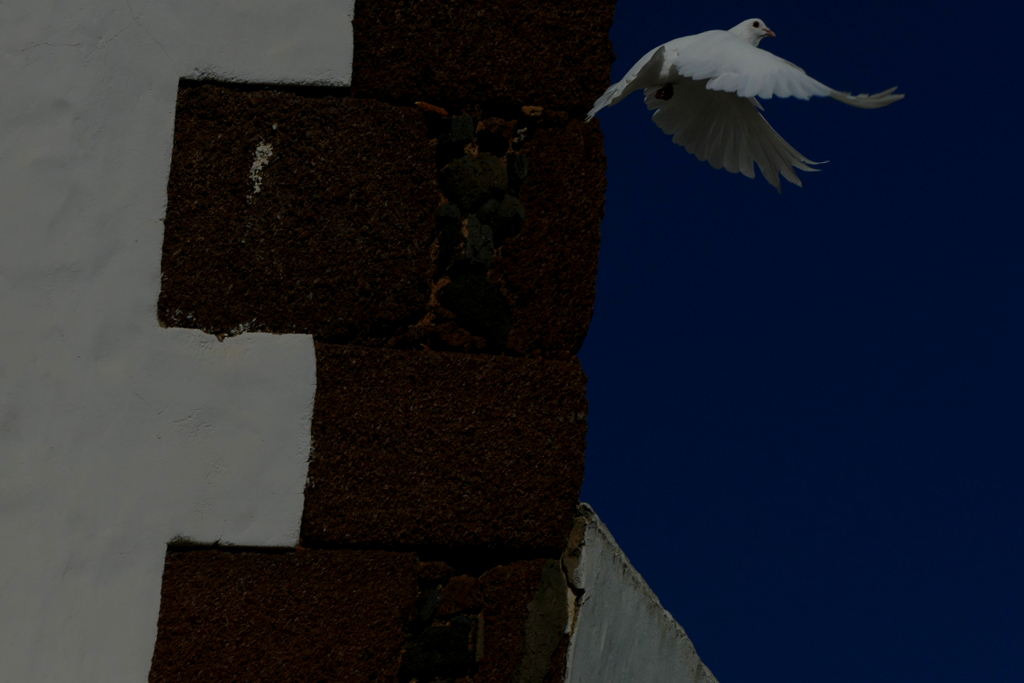
However, it was given its sinister name due to the attack by the Corsair Calafat in 1569. He had attacked the island on behalf of the Moorish King of Fez. His six hundred pirates came on nine galleys and destroyed the whole island. It is recorded that the blood of their victims gurgled down the alley when Don Agustin de Herrera, Marquis of Lanzarote, and his son
defeated 170 pirates in that very place.
Haria Valley of 1000 Palms
From Teguise, the tour continued up north towards Haría. Haría is located in the so-called valley of 1000 palm trees. Legend has it that in the past families planted a new palm tree each time a child was born – one palm tree for each girl and two palm trees for each boy. Over time, the valley became the greenest part of all of Lanzarote. The view from the top of one of the surrounding mountains is overwhelming – and from the bus speeding up the serpentines also quite petrifying.
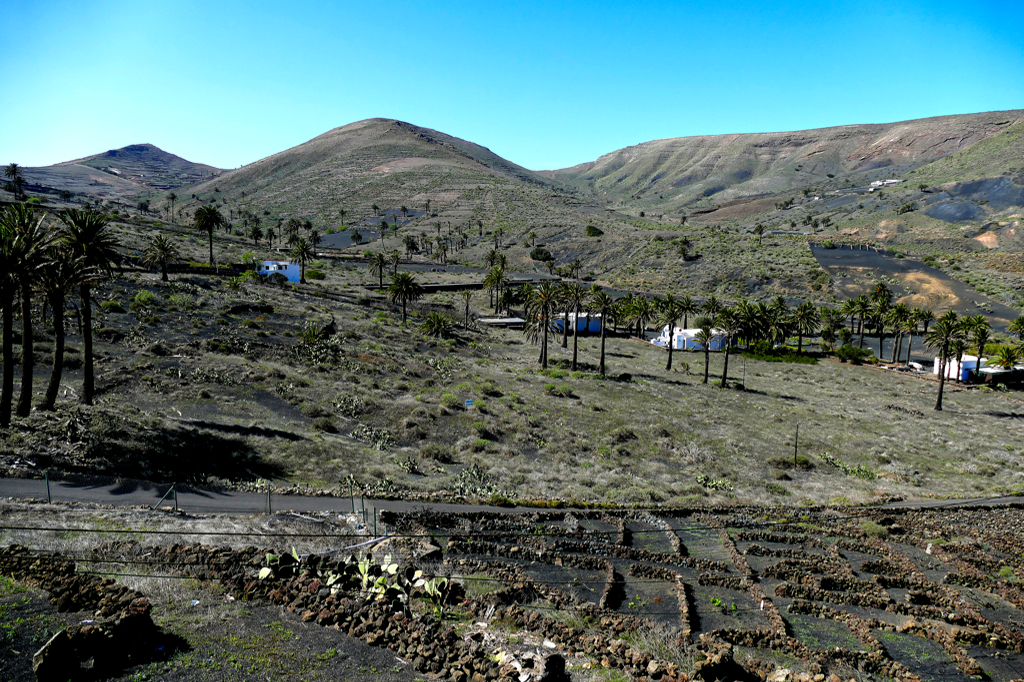
However, like other places in Lanzarote, too, Haría was frequently invaded by pirates. Almost all palm trees were burned down in a raid in 1586.
César Manrique chose Haría as his resting place – before and after his death.
Mirador del Río
It probably comes as no surprise that César Manrique also left his traces at the Mirador del Río. This viewpoint is located almost 500 meters above sea level on the cliffs of the Famara massif in the island’s extreme north. From up there, you have an amazing view over the cliffs and the two-kilometer-wide strait with the islands of La Graciosa, Montaña Clara, and Alegranza.
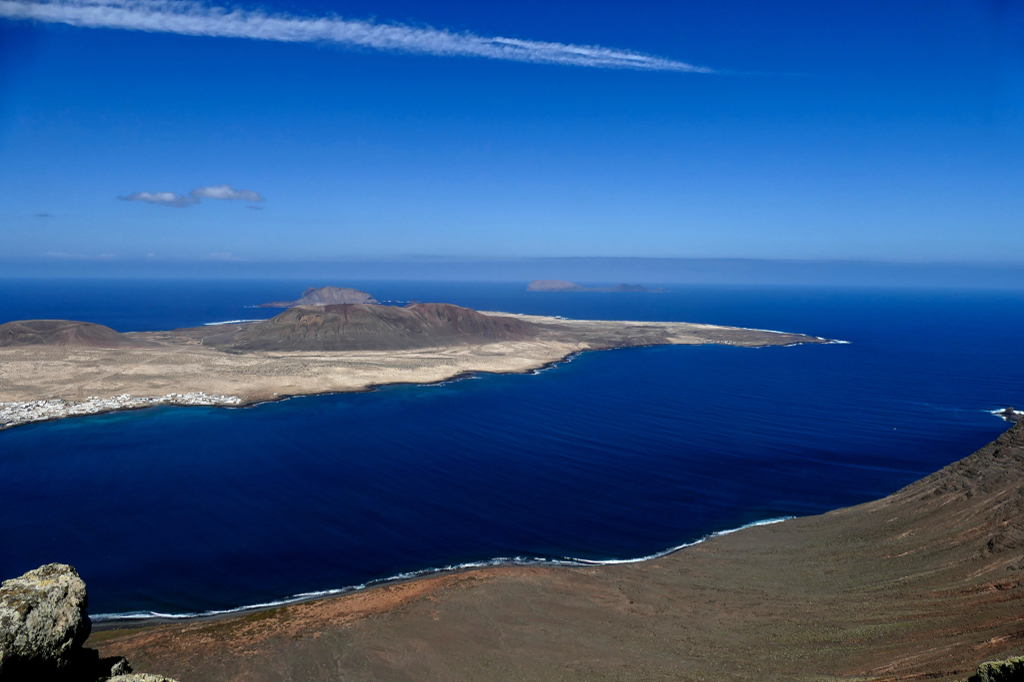
Manrique designed Mirador in collaboration with Jesús Soto and the architect Eduardo Caceres in 1973. Sticking to the typical organic Manrique style, the structure is integrated into the rock. Also, you won’t find a single right angle in the entire structure – not one! At the time of its official opening in 1974, it was considered one of the most important modern buildings in the world.
Cueva de Los Verdes
As you continue to the island’s east coast, you’ll get to another amazing place, namely to the Cueva de Los Verdes grotto. Needless to say, Manrique assisted Mother Nature in embellishing this longest lava tunnel in the world. However, it originates in the lava flow caused by the eruptions of the nearby Corona volcano.
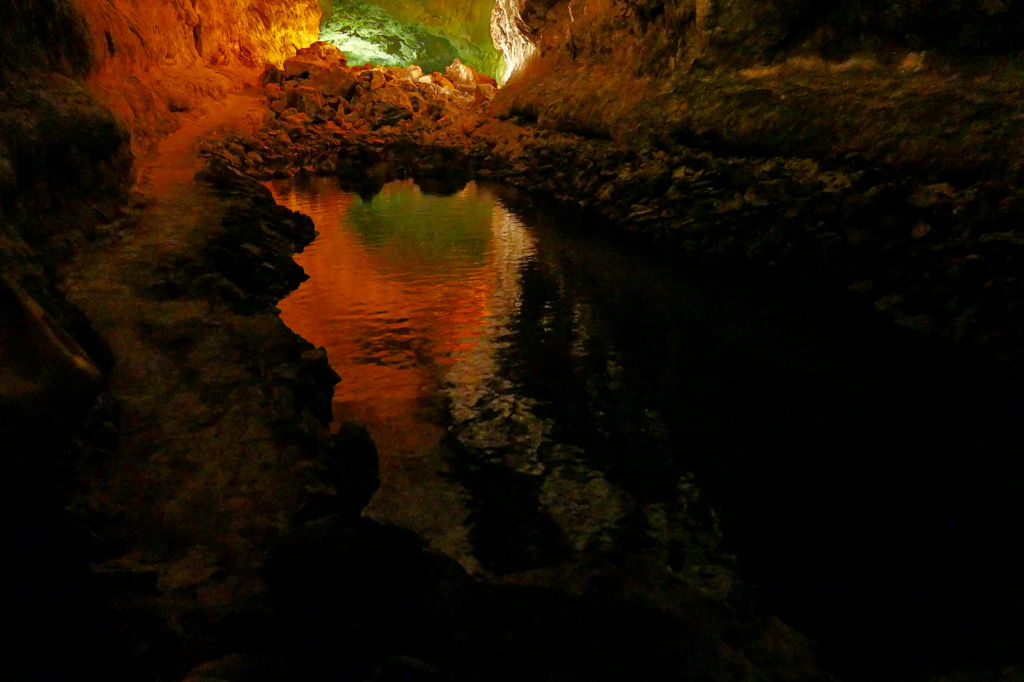
As a matter of fact, the Cueva de los Verdes is just one part of the seven-kilometer-long cave system. It begins at Montaña Corona and ends on the coast below the water’s surface. However, less than half of the caves are accessible, and large parts are still unexplored. In the past, the local population sought shelter from pirate attacks inside the cave.
The accessible part consists of two long tubes on top of one another. On our guided tour, we walked about one kilometer inside. One part actually serves as a concert hall which seats 300 people.
Jameos del Agua
Jameos del Agua is the part of the lava tube that extends from Monte Corona located closest to the coast. Designed by César Manrique, its most amazing feature is an underground lake where tiny white crabs are living. This is kind of a miracle since normally, you’d find them only in the ocean at depths of over 2,000 meters.
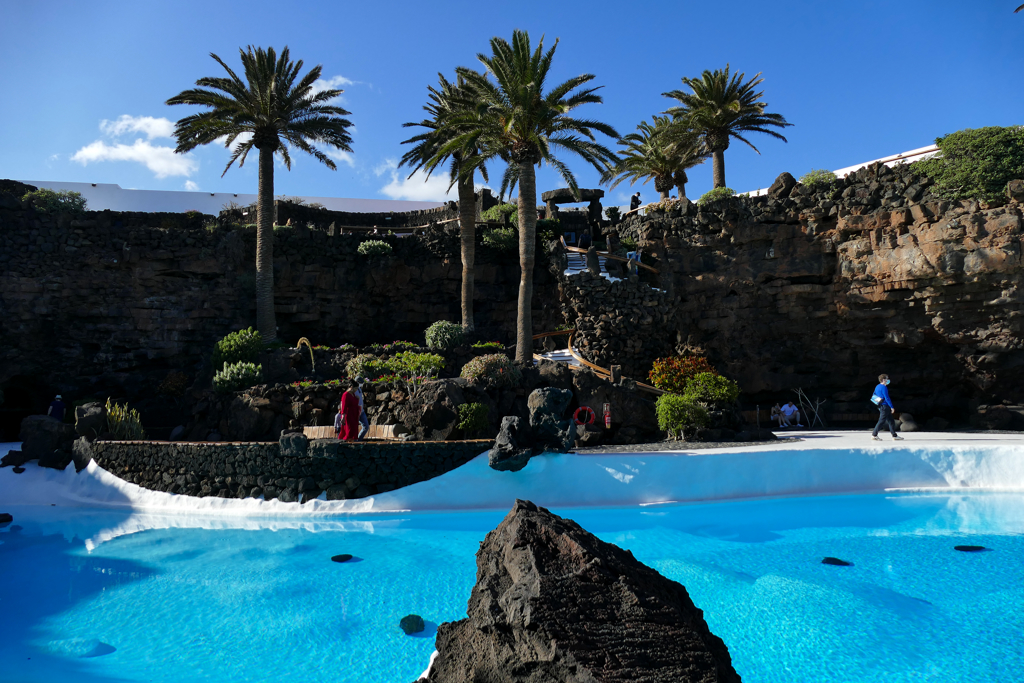
From the lake, a planted stone staircase leads up to a beautiful white swimming pool. Sadly, bathing is not allowed anymore.
Behind the pool is the heart of Jameos del Agua, another concert hall integrated into the grotto. And this one seats even 600 visitors.
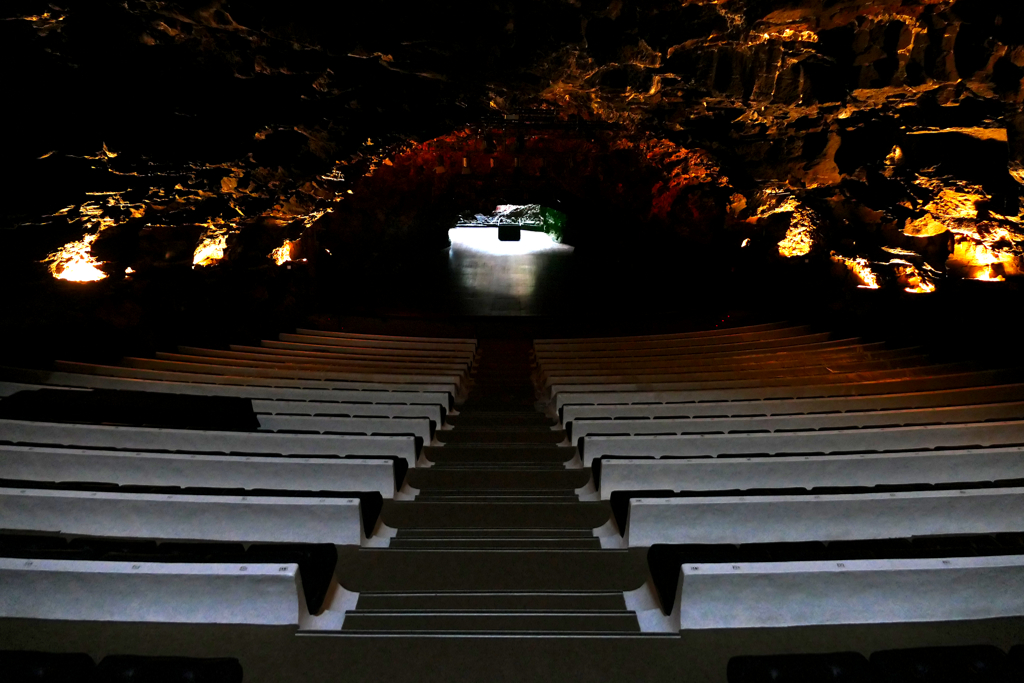
Another stone staircase leads up to the House of the Volcanoes where you get information on the volcanic processes in Lanzarote. They also have a restaurant and a nice gift shop.
So, after about half of the attractions in this post have the words César and Manrique in them, it might shock you that there is still another great creation that I didn’t get to see. Since they were shooting a movie at the Jardín de Cactus, the island’s cactus garden in Guatiza, the program of our tour had to be adjusted accordingly. Hence, when you go on a tour of Lanzarote, there is also this gem to add to your itinerary.
La Geria
At the end of every Lanzarote tour, one final attraction is waiting for the visitors. At least of those of drinking age which in most European countries is quite low. You get to sample the famous wines that are produced on the island.
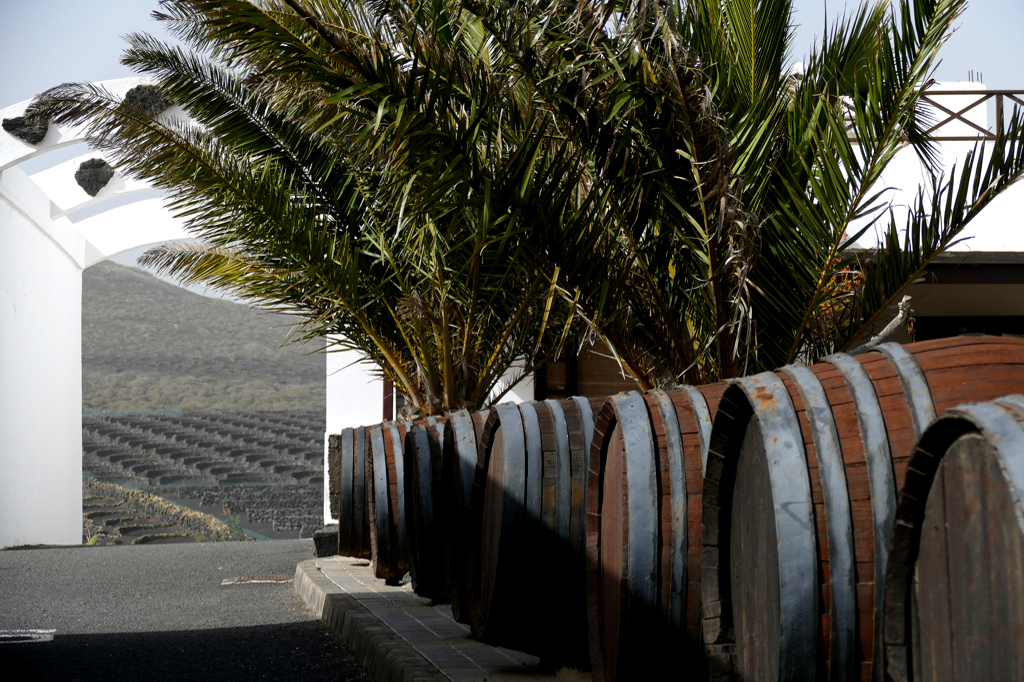
Various kinds of grapes grow on Lanzarote on around 2,300 hectares. It is in La Geria where most of the best-known wine cellars are located. Some of the wines from that region have been awarded prizes, mainly those from Malvasia and Muscat grapes.
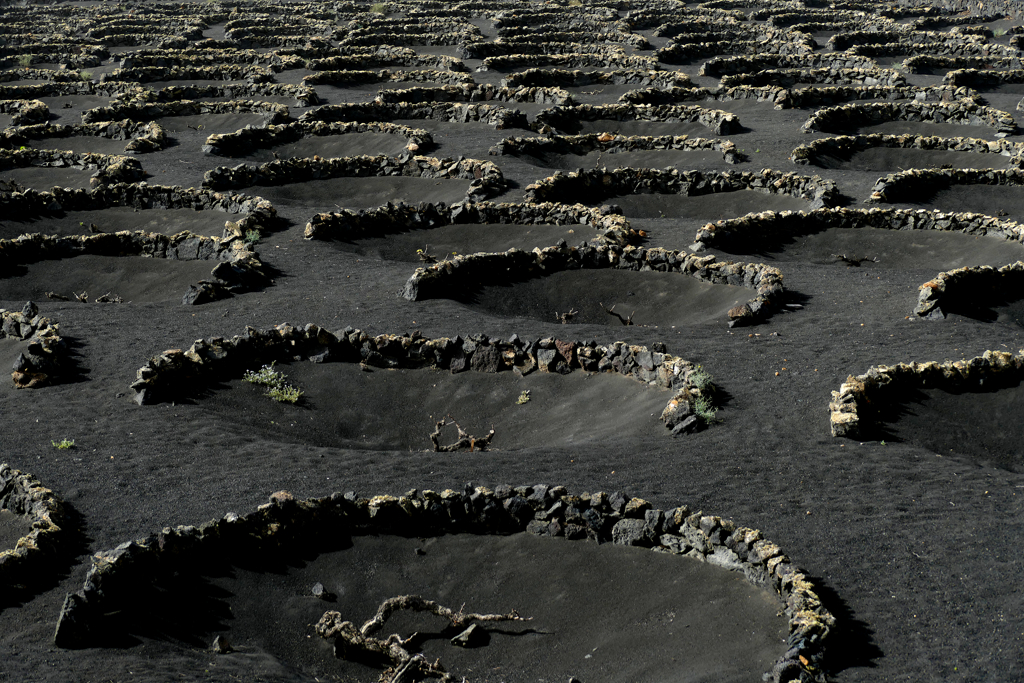
What’s unique in the world and therefore a trademark of Lanzarote’s wines is the way the grapes are grown. They don’t hang on vines but are nestled in semicircular lava walls. The ground is covered with so-called lapilli. Lapilli are volcanic rock fragments and ash. During the day, it heats up and at night, it absorbs moisture from the air.
So now, as our tour has come to an end, let’s take another one for the road. Salud!
César Manrique, Lanzarote’s Most Famous Son
I don’t know how many times I’ve mentioned Manrique in this post. But since he had a significant impact on Lanzarote’s cultural and in the end also economic development, there’s just no getting around him when exploring the island. Therefore, here is some more information on the man that shaped today’s Lanzarote.
César Manrique Cabrera was a painter, architect, sculptor, and environmentalist born in Lanzarote in 1919. In the 1930s, he fought as a volunteer alongside Franco’s fascist putschist in the Spanish Civil War. Since I’ve learned this little fun fact about El señor Manrique, I’m far less impressed.
Howsoever, he graduated from the Art Academy in Madrid with a master’s degree in drawing and painting in 1950. Manrique became one of Spain’s avant-garde pioneers. In 1954, he opened the country’s first gallery for non-figurative art in Madrid. His work was strongly influenced by abstract expressionism, pop art, and kinetic art, obviously.
Manrique returned to Lanzarote for good in 1968. There, he forged the modest plan to transform his home island into none less than one of the most beautiful places in the world. This included allowing only traditional edifices, and buildings were allowed to have three storeys max. Houses had to be white-washed and shutters, doors, and fences painted blue in fishing villages and green in agricultural areas. Eventually, the color brown was added. Also, billboards alongside the roads were forbidden. Since Manrique had ties with powerful people in the island’s government, he found all his wishes fulfilled.
Shaping the Land
Together with his friend, the artist Luis Ibañez, he purchased one of the three houses that were spared by the volcanic eruptions in the 18th century in the town of Yaiza. In 1970, he converted it into a restaurant.
The same year, he began to build a house in Tahíche. During construction, he uncovered a total of five lava caves which he then expanded and transformed into living spaces. Since 1982, this amazing structure houses his foundation. Manrique made his home in a remodeled farmhouse in Haría. Today, it houses the Casa-Museo César Manrique.
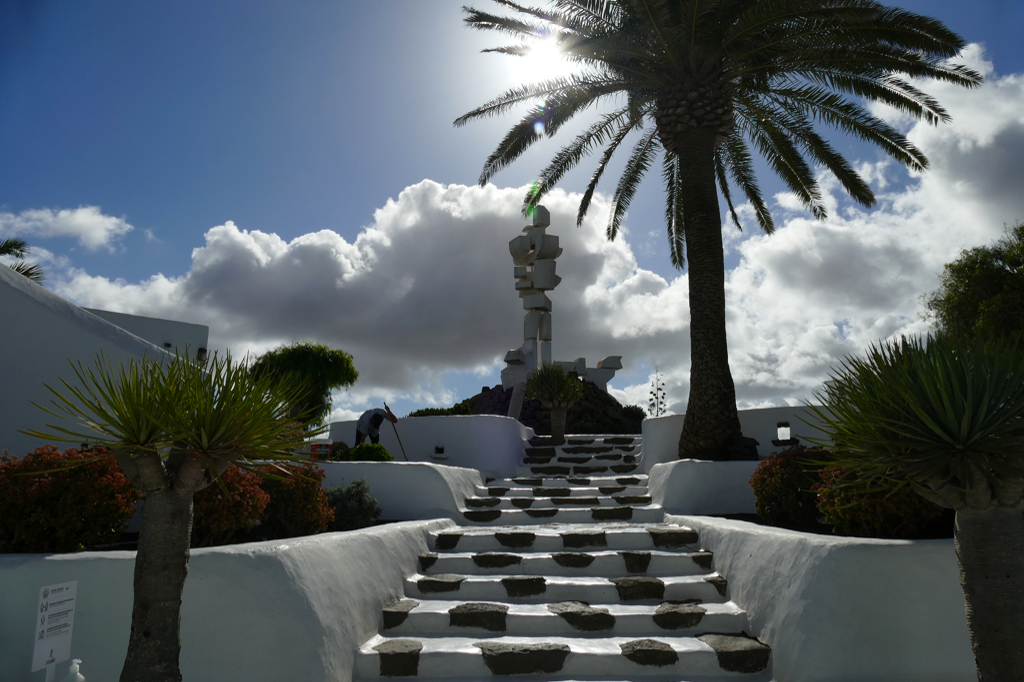
On September 25, 1992, Manrique died in a car crash. He is buried in the cemetery of Haría.
Manrique contributed to keeping the mass tourism in Lanzarote moderate. He was committed to preserving the island’s cultural identity. Sadly, this has slowly changed over recent years. In the tourist ghettos of Costa Teguise, Puerto del Carmen, and Playa Blanca, higher buildings were approved.
Yet, due to the island’s commitment to sustainable tourism, UNESCO declared Lanzarote a biosphere reserve in 1993.
Practical Information
How to Get There And Around
By Plane
Just guess after whom Lanzarote’s airport is named! Yap, you’re absolutely right, it’s called Aeropuerto de César Manrique-Lanzarote although he didn’t even design it. The airport is located in San Bartolomé about 5 kilometers southwest of the island’s capital Arrecife.
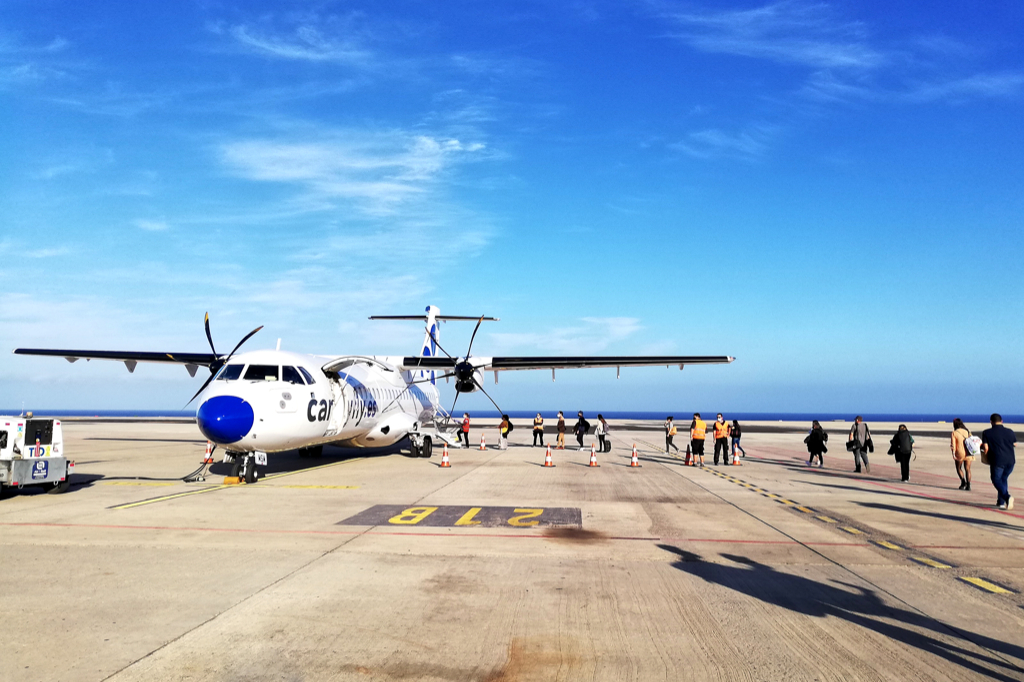
Obviously, there are flights to and from the other islands such as Gran Canaria and Tenerife operated by local airlines like Binter, Canaryfly, and Air Europa. If you check their websites, don’t get over-excited about the incredibly cheap prices as these apply only to permanent residents. However, even for other passengers, flying between the islands is reasonably priced and often cheaper than taking the ferry.
If you haven’t booked a package where the travel company arranges the shuttle from the airport to your hotel, you have different options for how to get to your final destination. The most comfortable option is taking a cab, obviously.
However, you save lots of money by taking one of the public buses. There are four bus lines connecting Lanzarote Airport with different spots on the island. Lines #22 and #23 are going to the city center of Arrecife. You get to Playa Blanca by #161 and by #261 to Puerto del Carmen. Find these and more timetables on the website of Lanzarote’s local bus company Arrecifebus.
I’m not driving, but if you want to rent a car, you can do so right at the arrival hall. There are different car rental companies to choose from. Actually, of all the Canary Islands I’ve visited, Lanzarote is the only one that cannot be explored easily by public transport.
By Ferry
The island’s largest seaport is located in the capital Arrecife. This is the island’s gateway to Huelva and Cádiz on the Spanish peninsula but also to the island of Gran Canaria. There are also indirect ferry routes to Tenerife and La Palma.
There are various daily connections from the town of Playa Blanca to Corralejo on the neighboring island of Fuerteventura as well as from the town of Orzola to La Graciosa.
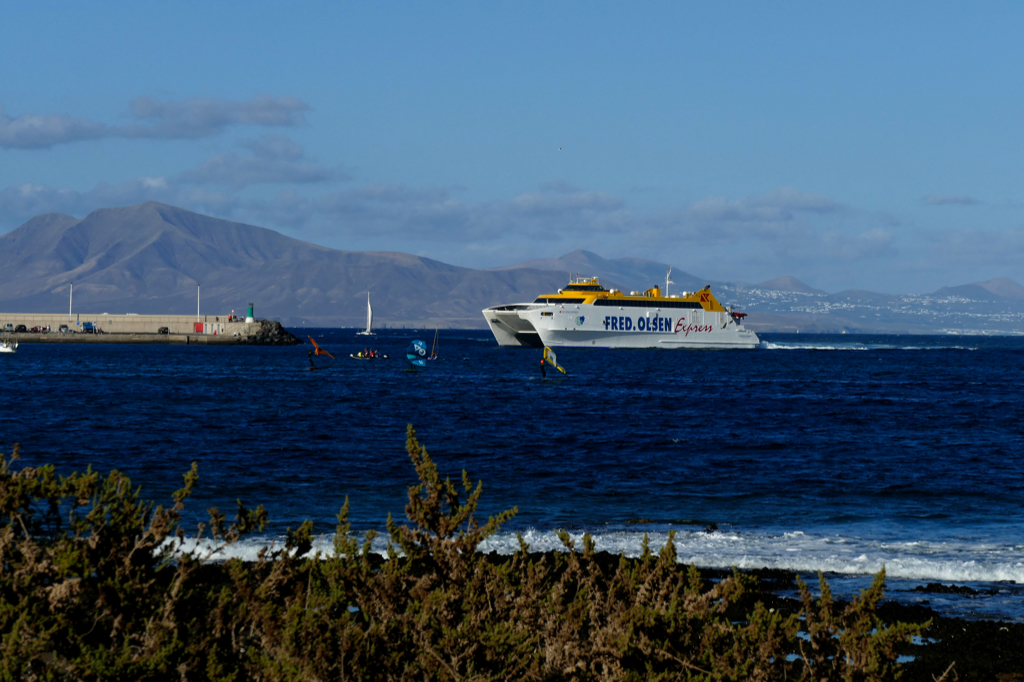
If you’re on a flexible schedule, you should check thoroughly the prices at different times of the day as well as between the individual companies as they can differ a lot. Also, just like the airlines, the ferry companies grant residents of the Canary Islands a considerable discount.
How to Get Around
Yes, there actually are public buses on the island of Lanzarote. In general, they connect the larger towns such as Arrecife, Puerto Carmen, Playa Blanca, and Costa Teguise. However, if you want to visit more remote places, things are not that great. Often, there are only one or two connections per day, mostly early in the morning and late in the afternoon.
While this might be okay if you are spending more time on the island. I was there for two days and no matter how much research I did, I didn’t find a way to visit all the places I wanted to see by public bus. Therefore, I went on organized trips: I arrived by an early ferry from Corralejo on the neighboring island of Fuerteventura and met with the tour company at a bus stop right in front of the harbor.
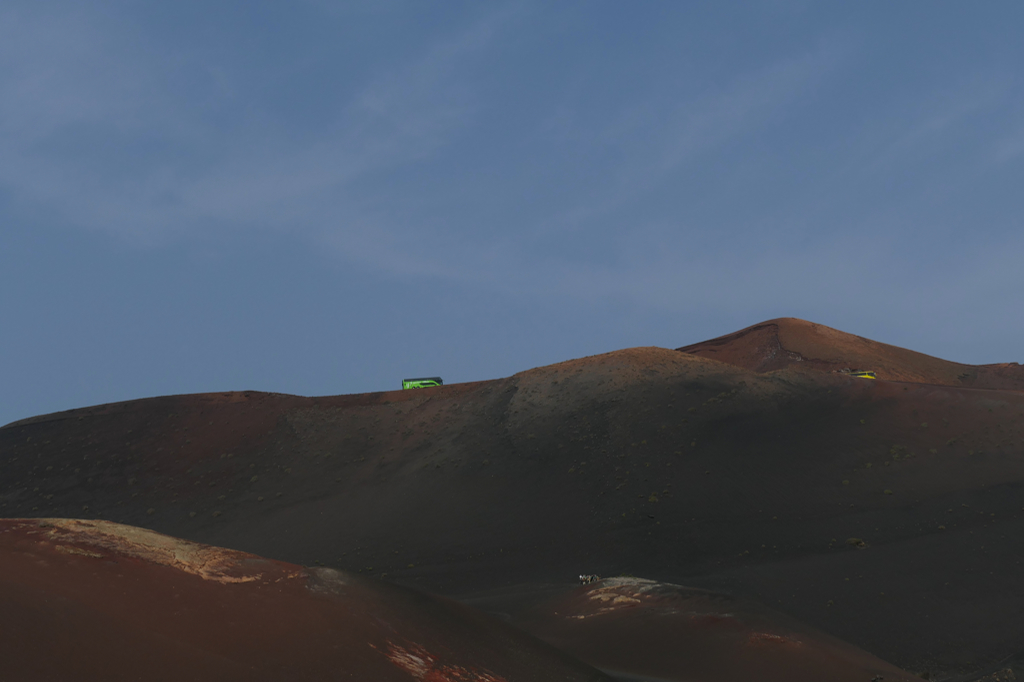
At the end of day one, they dropped me off at Playa Blanca where I spent the night at a lovely apartment, you’ll find it in the Where to Stay section below. The following day, I waited for the tour bus in front of a nearby hotel. At the end of day two, I spent another night in Playa Blanca before I went back to Fuerteventura on a morning ferry.
As a matter of fact, I did not have to spend the second night in Lanzarote since the last ferry crossed the La Bocaina Strait around 8 p.m. But I thought it would be less stressful to stay on the island one more night just in case for whatever reason the tour bus would be late.
Immigration and Customs
The Canary Islands are part of the Schengen Area and the customs area of the European Union. Since they are not part of the tax area for excise duties and VAT, certain products are way cheaper than on the mainland. Looking at the gas prices, for instance, will probably make you cry. Also, cigarettes and liquor are much cheaper, and, most importantly, cosmetics and perfumes. Especially in Lanzarote’s touristy towns, there are tons of shops selling these goodies.
There are hardly ever personal border controls within the Schengen Area. Yet, customs controls when coming from the Canary Islands are still possible. Therefore, make sure to keep your shopping within the allowed limits.
Organized Trips
As I pointed out, it was impossible to organize comprehensive tours by public transport in two days. Therefore, I joined organized tours that took me to all the places I’m introducing above.
Here are some suggestions of which tours to join in Lanzarote*:
Where to Stay
Lanzarote has been a popular tourist destination for decades. Although the building of soulless prefab monstrosities is not allowed, there are many huge hotels and apartment complexes. Nevertheless, you’ll find at least a small choice of lodging options even in the tiniest villages. In each and every hamlet, there will be a smaller guesthouse or privately rented apartments.
I was very happy staying at Casa Salzano* in the heart of Playa Blanca. It’s a big apartment that comfortably accommodates up to four people. Everything you need is close by, and even the harbor is about a ten-minute walk apart. However, if the Casa Salzano* should be booked out or you simply want to check out more suitable lodging options, you can do so on this map*:
What to Eat
The Canaries are gifted with an abundance of juicy fruits and veggies. There are rivers of the finest olive oil and the world-famous pork cerdo Iberico. Obviously, there is a rich catch of fish fresh out of the sea. Consequently, the cuisine is excellent.
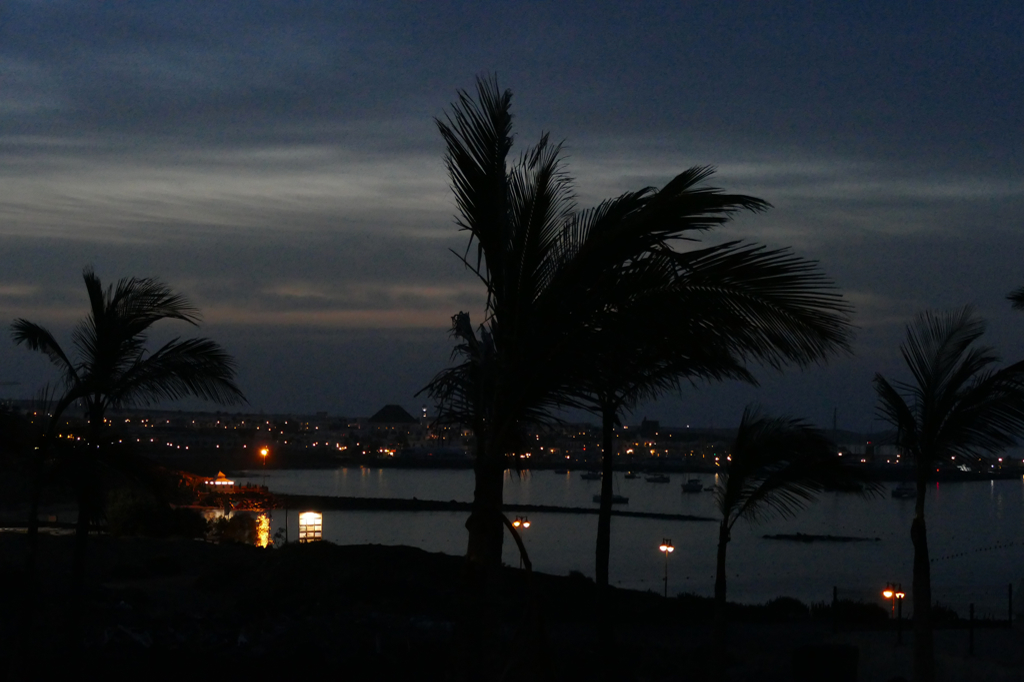
Yet, especially in the more touristy regions, restaurants tend to offer what tourists might consider traditional Spanish cuisine. Also, the menus are very internationalized with burgers and pizza and the like. Nevertheless, for instance, on Playa Blanca’s promenade, you’ll find many restaurants that prepare some wonderful fish dishes. And nothing can beat the view.
Tapas and Menú del Día
Just like on the Spanish mainland, there is an overwhelming number of bars and restaurants in the Canary Islands. There, you can enjoy a glass of beer or wine with some tapas, varied hot and cold snacks. They can be slices of serrano ham, diced or grilled cheese, papas bravas, tiny potatoes with a hot sauce, boquerones en vinagre, marinated fresh anchovies – the list is endless.
Normally, you’ll get some small complimentary tapas with your drink – at least olives or peanuts. A selection of two or three tapas can actually replace a meal. However, you can also order a ración, hence, a serving, or a media ración, a half-sized serving.
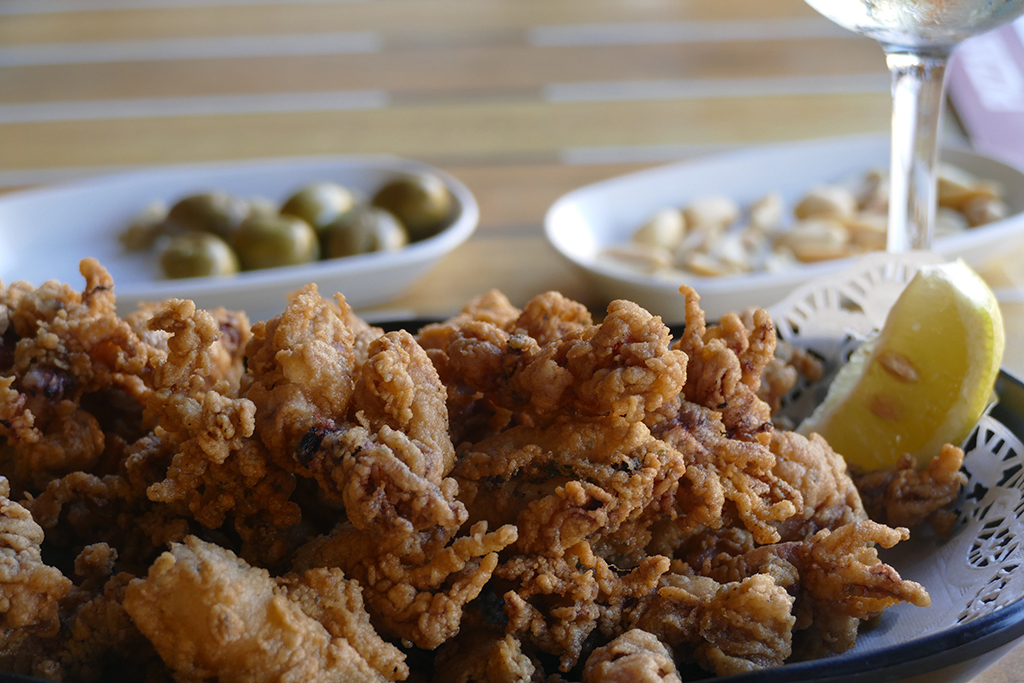
When you are really hungry, the menú del día might do. It’s usually a three-course meal. You can combine it to your liking from different starters, main courses, and dessert options. Often, the price of around 10 €uros includes water or even wine. However, the menú del día is usually just a lunch option and not offered at dinner time. Also, I’d like to point out that food options especially in Lanzarote’s more touristy areas are often rather international. Apart from all those local delicacies, you’ll find pizza, spaghetti, burgers, and other fast food on the menu.
As in most other European countries, tipping is rather optional in Spain. It is not compulsory, but an appreciative gesture. Also, you don’t need to calculate a certain percentage. Rounding up to the next full €uro might be a bit chintzy. However, adding one or two €uros will normally do.
Bakeries and Supermarkets
Just like in Italy, many Spanish supermarkets have a food counter. Here you can buy simple dishes like grilled chicken, meatballs, and fritters as well as sides like potatoes and salads.
I’m not claiming that this will be the fanciest meal of your life. Nevertheless, if you just need to grab a filling snack, I find it’s a valid option. Also, it’s a truly Spanish experience since it’s definitely not a touristy dining place.
Bakeries are selling all kinds of sandwiches and empanadas, savory pastry pockets. If you have a sweet tooth, you’ll also find a great variety of delicious pies. This is also a great breakfast option if you’re staying at a self-catering apartment.
While on the mainland, Spanish mealtimes can be challenging, in Lanzarote, they adapted to international feeding times. In the villages in the island’s hinterland, they might stick to traditional Mediterranean meal times. In the touristy areas, however, you can basically eat around the clock.
Cash And Cards
Until now, 20 European countries replaced their former local currency with the €uro starting in 2002. Obviously, Spain is one of them. The exchange rate is 1 US$ = 0.84 EUR as of October 2025. However, you can check today’s conversion rate on this page.
Especially due to the Covid pandemic, even small businesses prefer that you pay by credit card, preferably contactless. However, contrary to for instance Gran Canaria, you cannot pay on public buses with a credit card. You need to have either cash or a local travel card.
Nevertheless, banks or at least ATMs can be found basically everywhere.
Language
Before the Spanish conquest, each Canary Island spoke its own type of the Guanche language. Due to the systematic pushback of the local culture by the Catholic conquerors, only fragments of the language exist to this date. You mostly find those traces in the names of places.
Today, the official language is Spanish, obviously. If you want to learn some basic Spanish or just brush up on your knowledge, there are various apps and online tools. I personally like to practice with babbel. However, due to international tourism, most people working in tourism and gastronomy speak at least some rudimentary English and very often also German.
Nevertheless, here are some ground rules for Spanish pronunciation since saying for instance city names wrong can cause some problems. If people don’t understand where you want to go, they won’t be able to give you directions.
Say It Right
The good news is, that in general, you read Spanish the way it’s written. Although, the letter C is a bit tricky for foreigners. Placed before an A, O, or U, it’s hard and pronounced as K. Followed by E or I, it is pronounced like an English the. Now, if you want that th-sound in combination with A, O, or U, the letter Z comes into the picture. So you have to pronounce Canaria Kanaria, and Plaza Platha.
On the other hand, if you want C to sound hard in combination with E or I, you make it a QU – but you don’t hear the U. Fine example: Tequila, that you pronounce like Tekkila.
This applies also to the letter G. If it’s followed by A, O, U, or a consonant, it’s pronounced like the G in guitar or Gran. To make a G sound hard before an E or an I, they squeeze in a mute U – like in guilt. If G stands before an E or an I, it is rather breathed than pronounced – a bit like the H in house.
The same applies to the letter J. You always pronounce it like the H in house.
The last trap is double L which is not pronounced like an L but like a Y in yellow. So it’s not Malorca, but Mayorca. When a word is written with just one L like Tequila, it’s a simple and innocent L.
Connection and Communication
Since June 2017, no roaming charges apply within the EU with a European mobile phone contract. This applies to all 27 countries of the European Union as well as Iceland, Liechtenstein, and Norway. It pertains to all contracts.
When roaming is not available, you can connect to the internet at basically every museum, eatery, and, of course, hotel.
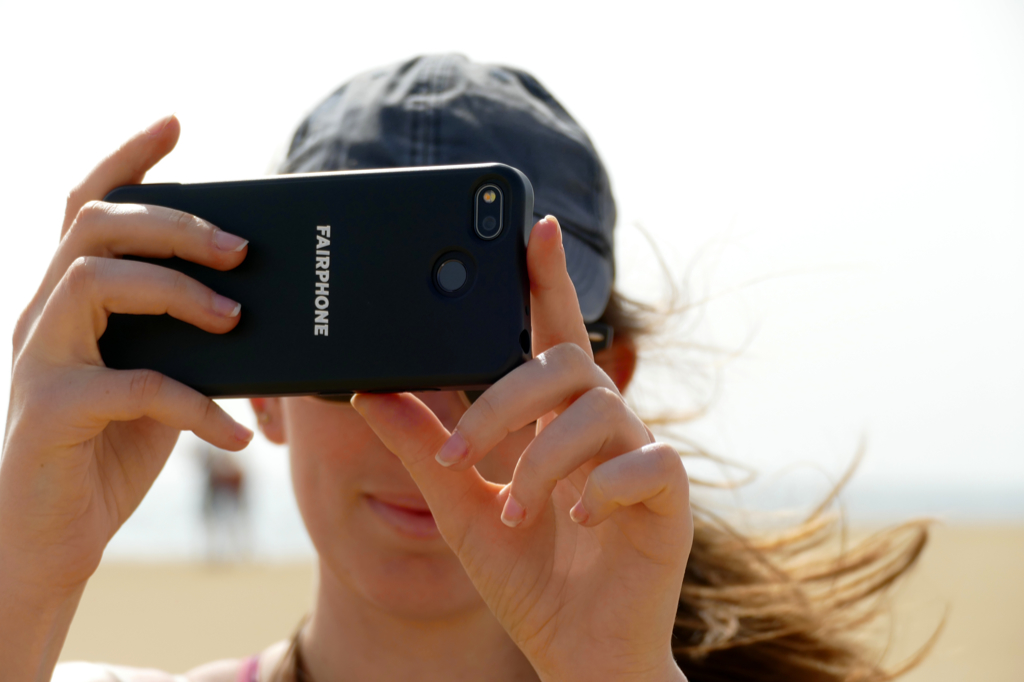
You can get a SIM card if you insist on being online 24/7. The cheapest one would be Lycamobile while Orange Tu Mundo has the widest coverage.
In Spain, they use plug types C and F. Their voltage is 230 V and the frequency 50 Hz. Nowadays, as all these chargers have integrated adapters, in general, the voltage and frequency don’t really matter.
By the way, you’ll find comprehensive travel info in my post World’s Most Complete Travel Information – an indispensable globetrotter-classic.
Map
On this map, I’m showing you where to find all the wonderful places I’ve seen in Lanzarote. This way, you can plan your tours accordingly. Clicking on the slider symbol at the top left or the full-screen icon at the top right will display the whole map, including the legend.
Pinnable Pictures
If you choose to pin this post for later, please use one of these pictures:
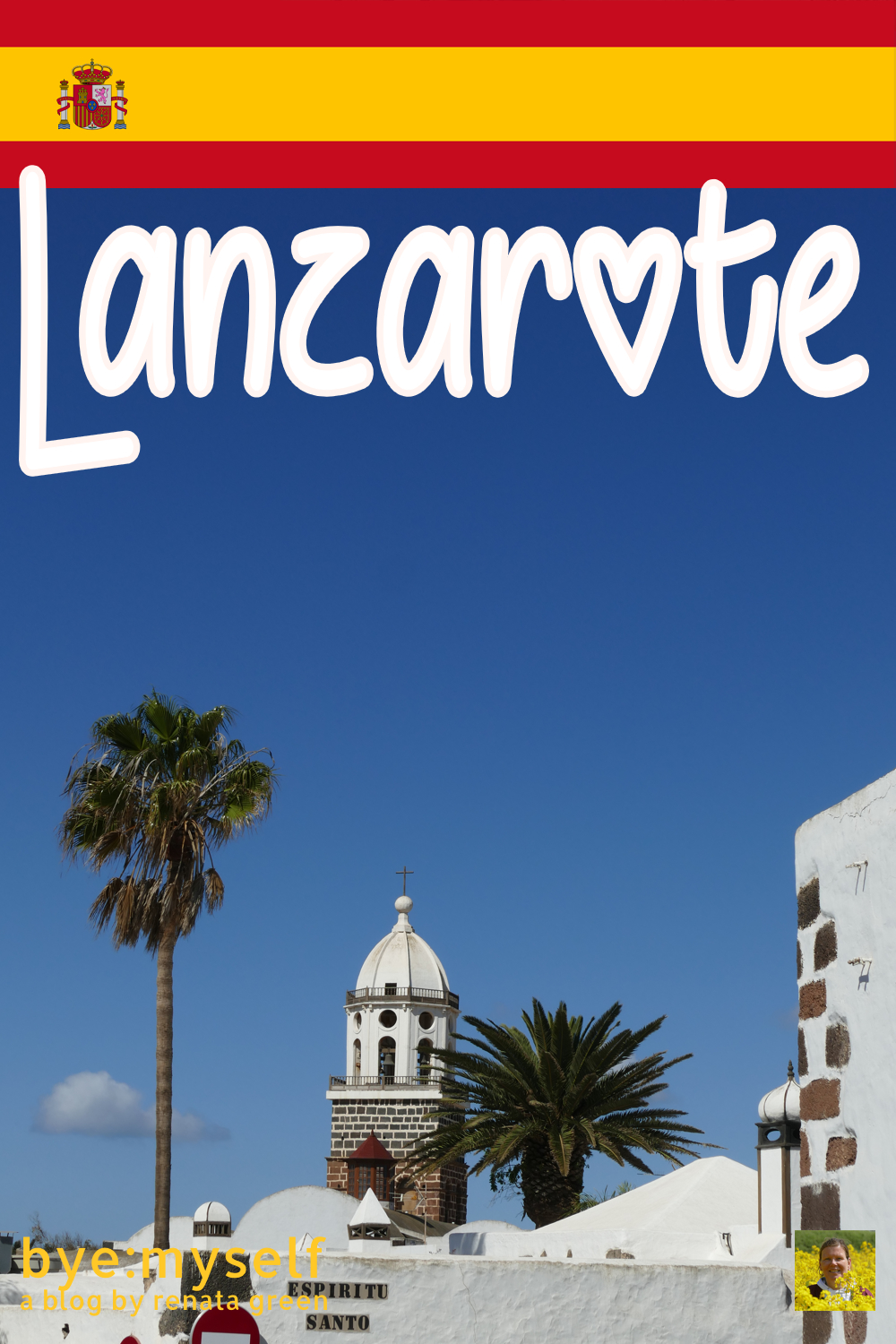
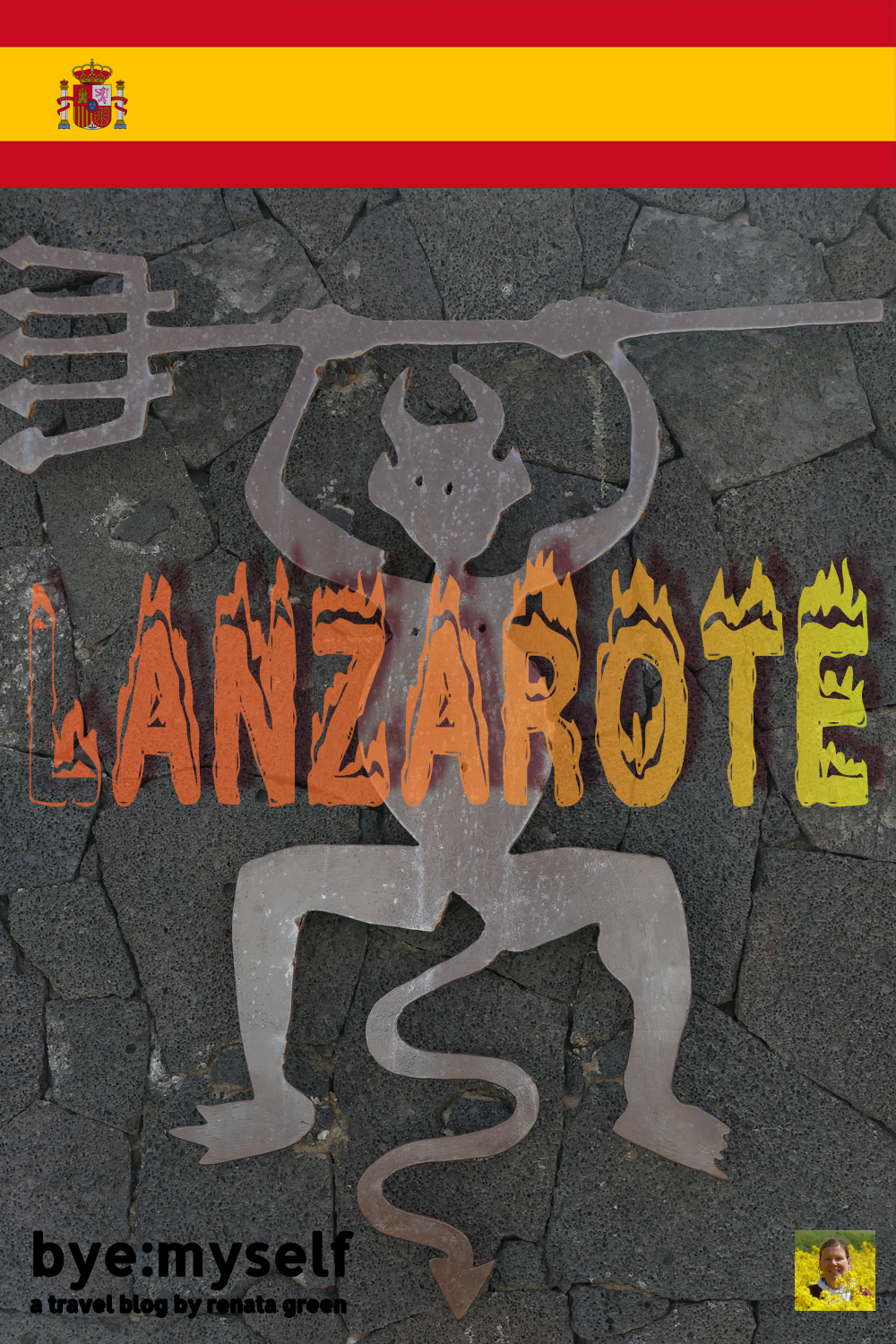
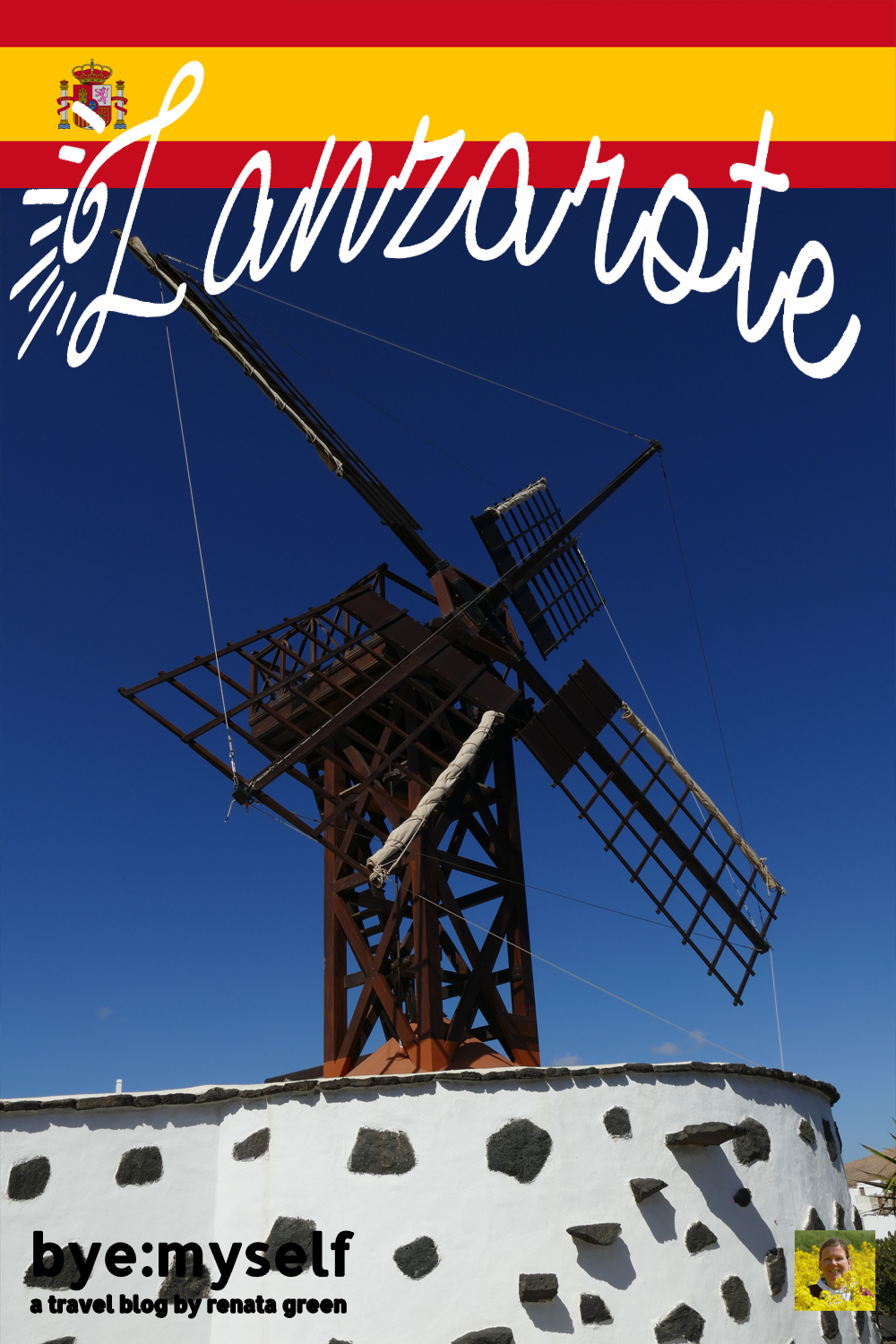
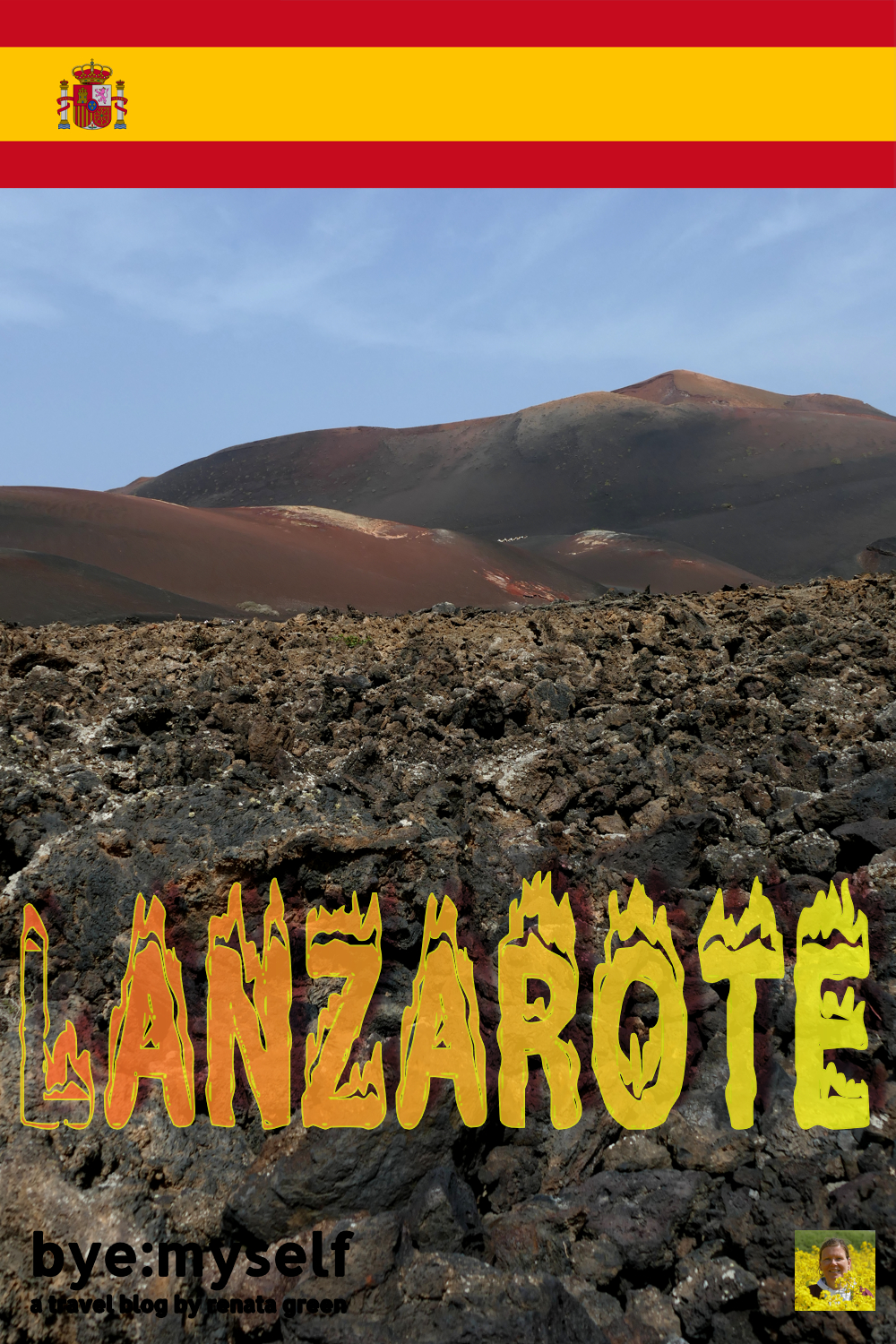
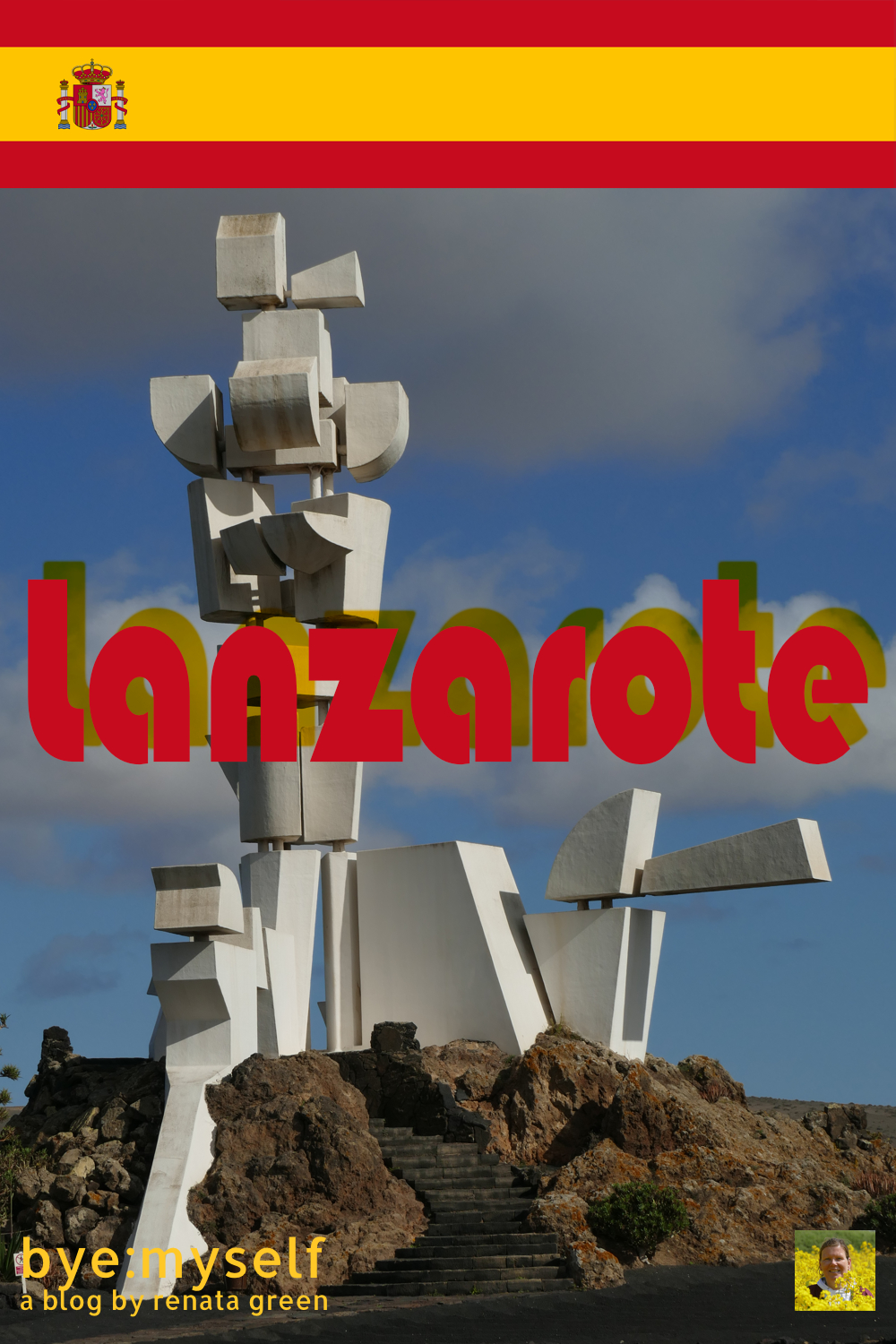
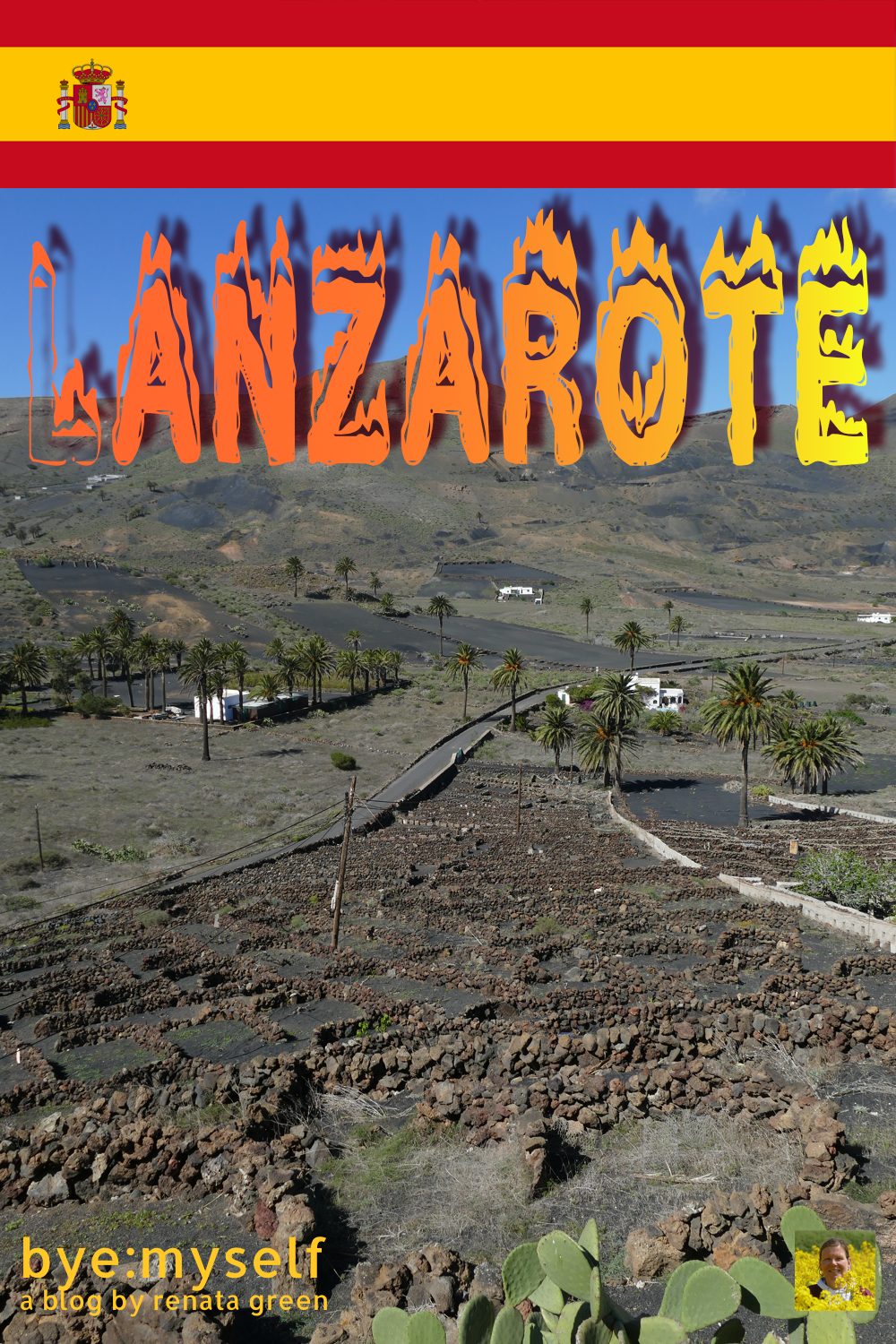
Note: I’m completing, editing, and updating this post regularly – last in October 2025.
Did You Enjoy This Post? Then You Might Like Also These:
24 hours in BARCELONA
Guide to RONDA – a White Gem in the Skies
From PORT d’ANDRATX to SANT ELM – Hike With a View
LA GOMERA – How to Explore the Canaries’ Ravishing Wild Child by Public Bus
Guide to GRANADA – The Heart And Soul of Andalusia
PALMA de MALLORCA – what to see in two days
Guide to SEVILLE – Three Days Right Where Andalusia’s Heart is Beating to the Rhythm of Flamenco
EL MEDANO – where not only the wind will blow you away
* This is an affiliate link. Hence, If you book through this page, not only do you get the best deal. I also get a small commission that helps me run this blog. Thank you so much for supporting me!
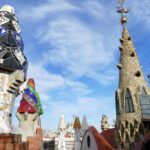
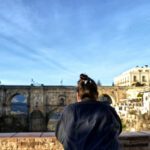
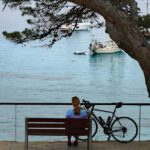
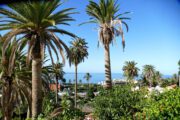
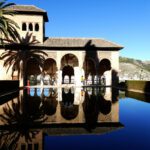


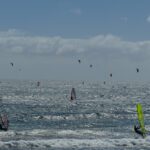
Reading your post I am a little bit sad, that we did not go to Lanzarote from Fuerteventura, even if it had been for one or two days. I have seen pictures of the Timanfaya reserve before and always wanted to go there. There is also a underwater sculpture parc somewhere on the coast. To see it you have to snorkel or dive. The small village of Teguise looks like another spot I would enjoy termendously. Well, I guess I need more than two days…..
I have to admit I was a bit surprised by how much I liked it there.
What an interesting place! I really enjoyed reading about the volcano history and the salt mining. How did the volcano-cooked meal taste? 🙂
Wow, this look so cool, and like what that guy did in the video. I would love to visit this place and see the view in real life. First time to know about Lanzarote. Thank you for sharing with us this magical trip to there.
Yap, it’s pretty impressive how much power there is beneath the ground we walk upon 😉 The guy was a lady, by the way 😉
Lanzarote seems fantastic island, full of unique nature, and offers great activities and attractions. For sure, I would like to see some of the volcanos. And I add El Diablo restaurant to my list to try some of those delicious. Teguise Village and San Francisco also seem great to visit.
Yes, there are so many phenomenons and landmarks that make the island truly unique – I was quite surprised myself, to tell you the truth.
So very cool; love the Nuestra Señora de Guadalupe and those lava soil grapes.. Plus that sunrise is definitely worth waking up for
Yes, there are so many truly unique things to see on the island, it’s amazing.
I must admit that my first visit to Lanzarote blew me away. I was not expecting the great variety in the sights we saw. And on our second trip back we did a wine tasting tour. Good wine but our tour was not so great. I’d like to go back and explore on my own around the island. And see more of the interesting creations of Manrique. I understand your comments about guided tours. But you sure got a good first look around to know where you want to re-visit.
Same here – I was amazed at how much beauty there is on the island since most people seem to just hang out on the beaches. To me, it was exactly the other way around: The tour was amazing – mainly due to the guide – but the wine was terrible 😀